#to the larger interstellar war stuff
Explore tagged Tumblr posts
Text
Thoughts on that kids show from the 2010s that changed the course of my life:
So, season 1 of Steven universe is really clever, because it shows the world from the perspective of a child in such an effective way. For example, the plot.
The viewers become aware of homeworld as a threat in ocean gem, but the crystal gems (other than Steven) know homeworld is coming from episode 2.
The red eye is the first thing homeworld does to check on earth, and the crystal gems are *powerless* to destroy it until the laser light canon is used (and that's *old* gem tech, not even the new stuff!)
In serious Steven, Coach Steven, and Steven's lion the gems are actively working to dismantle structures they had previously left untouched for thousands of years. Why? In case the diamonds try to use them.
Even after lapis' two parter the extent of why and how the gems are preparing for homeworld to attack isn't spelled out.
Pearl is trying to *escape* just like lapis did in Space Race, she knows it's possible... She knows if they leave earth they can be safe. Warp tour shows more explicitly that homeworld was already coming before lapis left, that even though she was Steven's introduction to the concept, homeworld was already interested in earth for other reasons. In rose's scabbard, they're clearly cleaning up the battlefield to keep extra weapons out of homeworld's hands, as it happens right between two major homeworld episodes, and just barely before the finale itself. Steven may not have known homeworld gems were coming for them, but the crystal gems did, the message only told them just how little time they had to prepare for it.
When you're watching Steven Universe for the first time, all this context slips past, you don't consider the reasons for the crystal gems going on certain missions, because the viewer doesn't have the information to even realize there was anything to consider (because the crystal gems are obviously keeping that info from Steven early on). Only on a rewatch does the exact level of urgency weigh in on the viewer, only when looking back do they realize exactly how much danger Steven was in even in the first season. It's a really clever set of details.
#i also really love the contrast between the fantasy asthetics and applications of era 1 gem tech compared to era 2#it makes the homeworld gems feel so alien and distant really effectively#and makes it easy to effectively transition from season 1's setup of the crystal gems going on lighthearted seeming fantasy adventures#to the larger interstellar war stuff#that ancient gem tech becomes basically unimportant after the end of season 1#because it just can't keep up against the new stuff.#also deep apologies to my best friend#who is probably tired of hearing me talk about Steven Universe at this point.#oh right#i shoulr use the tags for tagging this post#instead of just a parenthetical rant#Steven Universe#Fan theory#?
43 notes
·
View notes
Text
New headmate intro :)
Not everyone gets one cause not everyone wants to be social, but this one does but is also shy.
So, say hello to 273 (it/they)! (full designation 0000273)
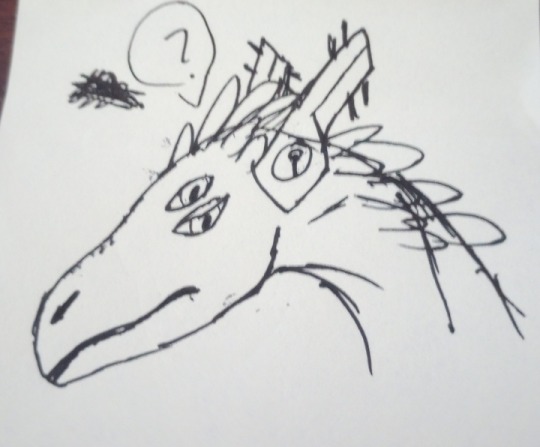

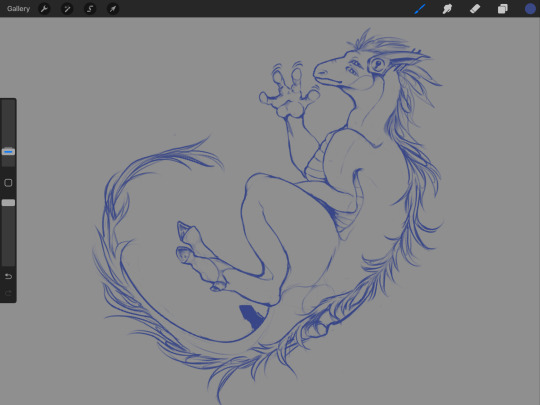
(traditional art by Lilith and 273, digital piece by @localoakbully <3 )
Big post cause it's a really interesting case as far as our system usually operates. It's kind of a fictive maybe? We made it as an NPC in the sci-fi homebrew we're running, so there are two possibilities:
1) We based the NPC heavily on someone who already existed in our head and gave it a backstory.
2) Aspects of the character we wrote aligned with stray part(s) in our head to form 273.
Either way, we (and it) realized it was there a few weeks ago now. We were helping a friend u-haul to another state and listening to The Murderbot Diaries, and some other system members noticed someone getting really into the story in a way we hadn't before. (We do often relate to SecUnit, but this was…another level.) And that someone was 273.
In the game we're running, 273 is a nanoswarm bioconstruct, basically an artificial animal-like life form made up of nanobots instead of biological cells. It was built, along with several hundred others, as a sentient weapon in the late stages of a massive interstellar war ~160,000 years ago. Constructs of its type can "absorb" smaller technological devices like phones and guns into their bodies for hands-free, speed-of-thought use, and inversely can integrate into larger systems, anything from a car to an orbital weapons platform, and take it over. They possess extremely durable bodies, a broad range of senses, and brains like quantum supercomputers. They were controlled by a series of governing protocols keyed to organic operators. A few decades after 273 shipped out of the factory, the alien war spiraled so out of control that all participant powers collapsed and/or fell to their own engines of destruction. 273 escaped and eventually went into a stasis pod for most of the intervening time, until the player characters found it. It's traumatized, amnesiatic, picking films for movie night on the ship, and learning how to function outside of its designated role. (So yeah, you can see why an entity with these themes would be into TMD.)
The real 273 can't do any of that stuff. In our system, 273 mostly sits quietly in our head and fronts to help with mundane tasks, run diagnostics on our body, or cuddle our partner. It's really good at the diagnostic thing, and we're grateful for that. It doesn't feel like it literally lived through the things the character did, but understands the character on a level the rest of us don't. (Like how Nav doesn't feel like he lived through The Locked Tomb series but fuckin gets Gideon.) 273 doesn't feel like a former slave-soldier who survived mass societal collapse, but it does feel artificial, alien, limited in interpersonal experience, sensitive to overstimulation, and the body pictured here IS its true form.
And, fun tidbit, after we introduced 273 to our partner, she said she could see it fronting when we roleplayed it in the games. Said there was something more than when we'd portray other NPCs.
So now that this is all out there, maybe you'll see our alien friend posting sometimes.
2 notes
·
View notes
Text
I'm doing some political fixing to my Campoestela setting...
The main thing that was bothering me is how humans fit. Since this is a setting with multiple sentient species, each with their own civilizations and cultures (because I dislike the recent trend of human-only sci-fi setting, it's an intentional retro throw). However, the main thing here that allows such a diverse setting is the presence of diplomats/traders (because no universal translator!) and standarized equipment. Where did the latter come from, though? If there are older space civilizations than humanity, it must be humans who adapt to that standard, and I'm not nearly creative enough to build an entire alien technology set. If it was humans who "created" space civilization, it would mean they're way too important in the setting and I want humans just to be one civilization out of many.
My solution is that there would be a mix of both; humans have their own set of technology but they have adopted some alien tech and customs. This also throws me back to the early history of this setting. My idea is that humanity spread on its own on the Solar System, developing some standard space technology (perhaps there are equivalents of the Soyuz running around) before they invented FTL and added other alien standards to their own technological base. So human spaceships are similar and quite compatible, but they are very different to other civilizations. FTL is a whole discussion on itself, how did things come from big slow generation ships to aircraft-sized spaceships? I'll deal with that later.
Another thing I was never happy with was with the "Confederación Esteloplatense" thing, it's an ugly name (ironically it sounds better in English, Silverstar Confederation). OF COURSE there is a Space Argentina, and more accurately they are the descendants of the generation ship Esperanza, which had a mostly Argentine crew. But I've decided that, at least loosely, Argentina is part of a larger whole that includes the whole of South America or Latin America. I'm going to call it the Cruzur Union, the Union of the Southern Cross (Cruz del Sur). Rioplatenses, or Esteloplatenses, are just one nation inside of this wider... nation.
To see it from a wider perspective now, I'm picturing humanity in Campoestela much like the Ancient Greeks and Phoenicians (the Poleis model), establishing trading posts, colonies, communities and such all over space, but these are mostly independent from each other and only organized in very loose trade leagues and cultural alliances, with exceptions, there are few truly interstellar states beyond that. This is the Poleis model I made in my Space Empires post.
Ancient Greeks poleis were sorted by dialect and cultures (Doric, Aeolic, Attican, Ionic, real stuff) and their mother cities (the metropolis. And so, the human communities, all very independent and belonging to many overlapping organizations and alliances are also loosely grouped by their origins back on Earth. I'm imagining there were a couple wars and conflicts between the Western Powers (US/Europe) and the Eastern Powers (Russia/China), with other blocs such as the Cruzur, the African Union, the Arab League, India and more eventually overtaking the two. This is in the far past by now, it's like talking about the Habsburgs in the context of the modern European Union.
So, in this context, Beto, our loveable Argentine space trucker, is from the Esperanza Federation (name pending), a loose interstellar trade alliance of the descendants of generation ship of the same name. However, this alliance itself is part of the Cruzur, the old goverment of South America which still has a deep cultural and political influence. And Beto himself considers himself Rioplatense or Argentine, depending on the context. Oh, and he is part of a spacer syndicate that might or might not be international too. And of course he does belong to a wider human civilization or cultural sphere. If this is all complicated, it's because it's supposed to be, this setting is a bit of a reaction against single-culture, single-empire civilizations in space opera.
Why am I not making it the URSAL? Because this is a retro setting in the style of space opera. In real life sooner or later, we're gonna become all Star Trek communists (this is not a joke)
It's funny that this is all just background for a space trucker and a gamer girl having silly adventures.
#cosas mias#campoestela#I'll have to look a bit more on ancient mediterrean poleis and trade to see how I can make this work
14 notes
·
View notes
Text
loose timeline bullet-list for spacehobbits!au
elves and dwarrow are the first species from middle earth into space due to a similar technological curiosity, and are quick to develop a relatively stable interstellar economy through trade (orcs appear several centuries behind and, still openly hostile and therefore unwelcome both in and nearby the territories of both races, are generally unable to retain any solid territorial footholds themselves for long, and generally cause trouble mostly through piracy and mercenary work)
khazad dum is the first major dwarrow planetside colony in space, its rapid expansion due to the discovery of mithril, an extremely versatile material when it comes to building advanced technologies, and combined with the minds of dwarrow engineers, is largely responsible for launching the dwarrow forward in their development of useful technologies by several centuries
mithril is a good bargaining chip, as its versatility removes much of the usual strain for resources it’s extremely valuable on its own, and as neither dwarrow or elvish technologies are shared cheaply, the economy remains competitive and relatively stable for a time
the planetside dwarrow colony of erebor is founded in another star system (one that’s very close to elvish territory) due to its high probability of containing mithril, causing a slight rift between the races (basically the dwarrow were like ‘is anybody gonna settle that’ and didn’t wait for an answer, which the elves really don’t like but since no direct claim had been made by them previously for the territory, there isn’t much to be done without starting a war)
the generally plentiful mithril reserves are further bolstered by the mines of erebor (and then further still when other planets in the system show further sources), the prices lower a decent amount, though the elves do not return the favor (the dwarrow are unhappy with this, though they are wealthy enough that it doesn’t matter too much, but if this was a game made by telltale, a little ominous bubble of ‘the dwarves will remember this’ would definitely appear)
hobbits are discovered by gandalf, who shares the knowledge with the white council, and the decision is made to keep them generally unknown and therefore protected
the colony of khazad dum is lost to a balrog lurking within the depths of the planet, and is subsequently abandoned, taking a decently sized chunk out both the dwarrow population and their mithril stores, upsets trade severely for a time
prices raise again, in a rapid attempt to bolster their economy following the tragedy, elves drive their own prices even higher in turn, this creates some more bad blood, though they’re still rich in mithril stores with erebor’s territory
humans arrive, a couple thousand years after the elves and dwarrow first pushed into space, and as their desire for expansion is rooted more firmly in the issue of overpopulation rather than intellectual pursuits, they settle into the economy, providing lower-end services such as trading operatives, vessels used for shipping and trade, dock workers, etc, for much cheaper prices than what both dwarrow and elves might offer
the dwarrow are the first to capitalize on this, providing an array of lesser technologies (though still better than what the humans possess) for generally fair prices and services, creating a strong tie between them. trade with the elves doesn’t become uncommon for either race necessarily, but it does fall a bit by the wayside, their lifespans and corresponding level of skill factored perhaps too permanently into their prices (think like, if you just want a burger, you COULD spend $50 down the street at the fancy place and hopefully get some masterclass chef stuff, OR you could just go to mcdonald’s and spend $4 and still be just as full at the end) and you know the drill, ‘the elves will remember this’
under thror’s rule, the dwarrow become the stable center of interstellar commerce, the area around erebor the most diverse and high trafficked in the cluster
the larger space station named dale is completed, giving the humans a both cultural center and active trading hub within erebor’s territory, furthering relations between the two species
accumulated bad blood between elves and dwarrow and the blossoming friendship with the humans has understandable effects on trade within the cluster, the dwarrow charge much higher prices for their mithril when dealing with elvish merchants, and while the elves are self sustainable in a way that humans cannot boast, they still desire the material greatly (and already feel a bit cheated by the dwarrow settling erebor), and will pay for it, though the tensions between them bubble with a more outward hostility
tensions remain at an all time high, and the elves retreat almost entirely from the economic trading system
thror’s suspicions begin to grow with the elves’ sudden lack of interest, security is tightened to prevent any possible move to usurp their economic position
the elves’ general disappearance also fosters a less healthy relationship for humans with the dwarrow, as the dwarrow begin to lean into the human’s dependence on the dwarves for trade, and before long under thror’s rule prices begin to steadily rise (this creates some amount of civil unrest for both dwarrow and humans, tightly wound as they are) and over time their economic relationship with humans also begins to sour
subtle counter offers from elvish territories begin to pull human attention away, and, though dale still functions and functions well (for now) a large portion of humans begin to move out of the territory, thror’s anger at this (expected, technically, if not in that manner) turn of events leaves him refusing to lower prices or provide alternative options, and while the dwarrow remain a large part of trade and are still generally self-sufficient through mithril, the ereborean economy loses much of its hard won stability
destabilization attracts pirates, mercenaries, and soon rumors tell of the occasional pack or orcs or worse that linger just outside claimed territory, preying on trading vessels and travelers alike
the modest human colony of esgaroth is developed within elvish territory
civil unrest turns thror’s suspicions more local, prices keep rising, security tightens ever further, and the wide-reaching a.i. smaug is created to keep close track of any fluctuations in market pricing and populations, paid taxes, etc
smaug is developed further as the economy begins to capsize, providing both a source of cheaper labor en masse, as well as security advancements planetside or otherwise (military included)
an unknown development of malicious coding causes smaug to turn on erebor and it’s surrounding system, killing thousands and collapsing the local economy within the span of a day, forcing the dwarrow and few remaining human residents to flee with what little resources they have on them, and are left unable to return
elves refuse to give aid to the dwarrow though the arriving humans settle without much fuss into the colony of esgaroth, though the invitation does not extend (both for reasons of past soured relations and a general lack of ability to support the incoming population without elvish aid)
in a desperate gambit, thror pushes the refugees to khazad dum, in an unsuccessful attempt to reclaim their abandoned colony, which has since been settled by orcs, resulting in the loss of many lives, including his own as well as his son’s disappearance
under thror’s grandson thorin ii, the remaining dwarrow’s continued exodus sends them ill prepared through treacherous areas of space, until they are reach some of their smaller, more distant mining colonies in an asteroid cluster, and though many are accommodated as well as possible, it horrendously destabilizes the areas resources, sending many dwarrow further and further and resorting to cheaper and cheaper work to provide for themselves and their families
a wizard and a dwarf walk into a bar, and plans to take back erebor are begun
#spacehobbits!au#I should reread this ramble before posting I’m sure the tenses are everywhere#BUT I’M NOT GONNA :D#I may tweak it but this is a fairly generalized timeline in my head
31 notes
·
View notes
Note
now that it's over, thoughts on Bendis' Superman as a whole?
pretenderoftheeast said: So, thoughts on Bendis' Superman and Action Comics' tenure altogether and separately now that it's over?
Anonymous said: Best and Worst things about Bendis' Superman run
Anonymous said: Now that it is over, what are your thoughts on Bendis' runs on Superman and Action Comics as a whole?
Anonymous said: Retrospective thoughts on Bendis' Superman as a whole now that it's, I guess, done?
Anonymous said: Hey so since Bendis’ Superman stuff seems to be done, what did you think of the run as a whole?

I decided to hold off a bit on writing on this one, if only so that I could reread the Action Comics side of it since Superman stood out in my memory a lot more. But now I have, and as we’re heading into a bold new era of Superman (and it’s coming in fast - just since I made my Superman in 2021 predictions we’ve gotten Ed Pinsent finally reprinting his legendary bootleg Silver Age Superman, Steve Orlando announcing his Superman analogue book Project Patron, an official shonen Superman redesign for RWBY/Justice League, PKJ’s Super-debut turning out far better than I ever expected, Superman & Lois’s first proper trailer largely taking people pleasantly by surprise, and my learning that there’s a Sylvester Stallone Old Man Superman analogue movie titled Samaritan coming out this summer) we’re ready to take a look back with at least a touch of perspective. I’ll lead with complaints, so everybody who’s been waiting for me to say that Bendis on Superman was Bad, Actually, savor this because it’s as close as you’ll get.
The Bad
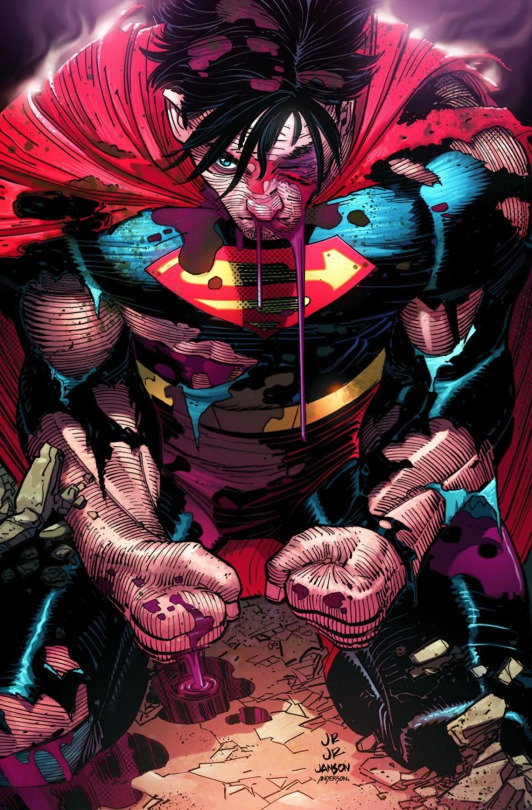
* I hate to say it, but rereading that side of the run there’s no two ways about it: the structure of Action Comics as a whole is a mess. It baffled me from day one that it was the more acclaimed of the two books for so long - I guess people are hardwired at this point to think of ‘street’ stuff as where Bendis is supposed to be - because it was immediately clear that Superman had a well-defined story he wanted to tell, while Action was the usual Bendis off-the-cuff improvisation. It’s barely even a story in the same way, and it’s certainly not the ‘Metropolis crime book’ people took it as: it’s 28 issues of Superman and his supporting cast stuffed a pinball machine with the Red Cloud pinging off of each other as we wait to see who falls in the hole at the bottom, and partway through Leviathan and the Legion of Doom and 90s Superboy are tossed into the mix to keep it going a little longer. On an issue-to-issue basis it’s frequently really good, but the core plot of the book is *maybe* six issues stretched out over two and a half years.
* I’ve gone into this some before, but structure-wise Unity Saga also has problems: Phantom Planet rules but either it needed to be cut or the back half needed to be a year all its own in order to accommodate the scale of what it’s attempting. It’s got an interstellar civil war leading into the formation of the United Planets, family drama, Rogol Zaar’s whole deal, and Jon’s coming of age, and I’d say only that last one is really properly served. Even Jon forming the United Planets, while contextually somewhat justified in terms of 1. The situation being so far gone he’s the only one who’d even think in those terms, 2. Things being bad enough that these assorted galactic powers would be willing to try it, and 3. Him having the S on his chest to sell it, isn’t at all built up to within the run itself.
* Rogol Zaar sucks. He’s made up of nothing but interesting ideas - he’s an ersatz warrior ‘superman’ of a bygone age of empires up against the new model, he’s the sins of Krypton as a conservative superpower come home to roost, he’s while not outright said to be definitely Superman’s tragic half-brother and the culmination of everything this run does with Jor-El - but none of them manifest on the page, he’s just a big punchy dude with a dumb design who screams about how you should take him seriously because he’s totally the one who blew up Krypton. Even a killer redesign by Ryan Sook for Legion of Superheroes can’t fix that. There are lots of bad villains with good ideas who are redeemed with time and further effort, but I can’t imagine Zaar getting that TLC to become a fraction of whatever Bendis envisioned him as.
* The second year of Action Comics, after establishing itself in its first as one of the most consistently gorgeous books on the stands, leads with Szymon Kudranski’s weak output and then concludes with John Romita Jr. turning in some career-worst work. The latter is particularly egregious because for that first year Bendis writes a really collected, gentle Superman so him getting pushed into being more aggressive should have an impact, but Romita draws such a craggy rough-looking Superman in the first place that it mutes any sort of shock value.
* WE NEVER LEARN WHAT’S UP WITH LEONE’S CAR, WHAT THE HELL. You don’t just DROP THAT IN THERE and then NEVER FOLLOW UP.
The Good
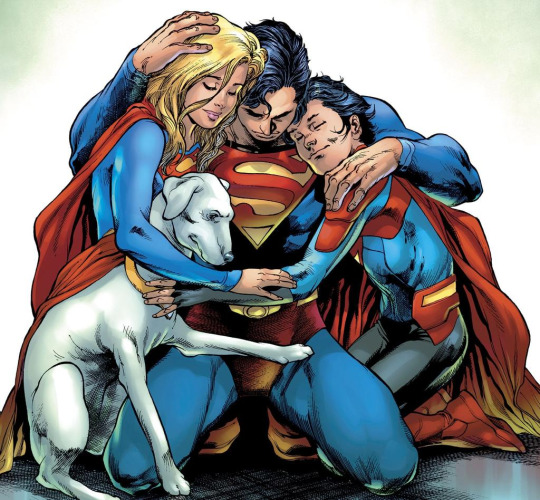
* Superman got his real clothes back after 7 truly ridiculous years.
* Bendis fundamentally gets Clark’s voice in a way unlike almost any other writer - even all-around better writers of the character almost never approach how spot-on he is with having Superman speak and act exactly how Superman should.
* Supporting cast front and center! He writes a dynamite Lois, Perry, and Jimmy (even if many of Lois’s more out-there decisions in the run don’t end up retroactively justified the way you’d hope), Ma and Pa are more fun than they’ve been in decades in their brief appearances, he manages to turn having Jor-El in the mix into a positive, and the Daily Planet as a whole has an incredibly distinctive vibe to it like never before that I hope is taken as a baseline going forward.
* The non-Rogol Zaar baddies? All ruled. Invisible Mafia and Red Cloud are both brilliant ideas executed solidly if overextended. Zod as Kryptonian Vegeta, Mongul as a generational perpetual bastard engine primed to be incapable of self-reflection, and Ultraman as “what if Irredeemable but he’d never been a good guy and also he was a Jersey mobster” are the best versions of those characters by numberless light-eons. Lex is on-point in his sparse appearances. Xanadoth as a mystical cosmic monster older than time who still talks like a Bendis character is however unintentionally a hoot. The alt-universe Parasite is a more intimidating Doomsday than Doomsday ever was. And Synmar as an alien culture’s attempt at creating their own Superman and messing up the formula when they make him a soldier can and should be a legitimate major ongoing villain coming out of this run.
* Pretty much all the art other than what I mentioned already. Fabok does a good job bookending The Man of Steel and Ivan Reis does the work of his career anchoring Superman (special props to Reis as well for drawing the first ever non-Steve Rude interesting-looking take on Metropolis), and meanwhile you’ve got Jim Lee, Jose Luis Garcia Lopez, Doc Shaner, Steve Rude, Kevin Maguire, Adam Hughes, Patrick Gleason, Yanick Paquette, Ryan Sook, Brandon Peterson, and David Lafuente doing their own parts.
* Closely related to the art, all the little flourishes with the powers. Super-speed having a consistent visual with the background coloring changing, Clark internally putting numbers to the degrees of force behind his punches and what situations which numbers are appropriate for, ‘skidding to a halt’ mid-flight before crashing through a window, the shonen-ass major throwdowns as portrayed by Reis, how his super-hearing is handled as a prevalent element. Lots of clever bits that added flavor to what he does.
* While Unity Saga has problems, the whole of what Bendis does in Superman as a means of forward momentum for Clark and his world is excellent. The sort of three-act structure of:
** Clark is led to question his place in things over the course of a few adventures
** Involvement in the larger cosmos and the impact it has had through and on his family makes him realize the answer to his questions is that he needs to step up in a bigger way because there’s no benevolent larger universe to welcome Earth with open arms, nor a cosmic precedent for everything turning out for the best without some help
** As a consequence of the lessons learned by this change in the status quo Clark is inspired to make his own personal change in revealing his identity (with Mythological basically being an epilogue showcasing a ‘standard’ standalone Superman adventure while simultaneously highlighting his new status quo and how it fits in as a summing-up of Bendis’s take)
…does a great job of shepherding through ideas that lend a lot of forward momentum to Superman of the kind he hasn’t seen in a long time. Not perfect, but far lesser stories with far lesser ambitions have made huge impacts, so I’d certainly hope at least some of this sticks around even if, say, regardless of any retcons to the main line there are always going to be stories with Clark as a disguise and Jon as a kid. Oh, speaking of whom,
* KISS MY ASS, EVERYTHING WITH JON KENT RULED
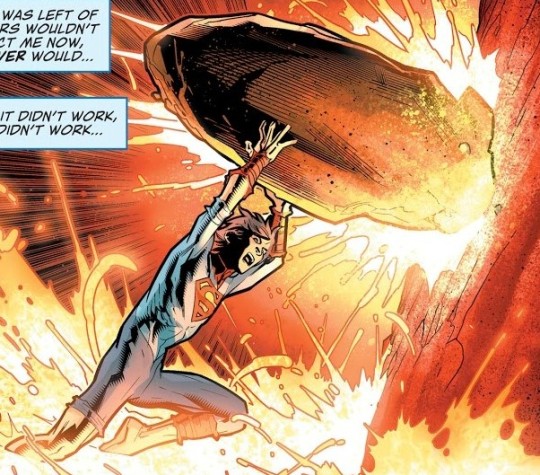
Ahem. Probably a less confrontational way of putting that.
Do I think there was more gas in the tank for Jon as a kid? Totally, making him likeable and viable was the one really good thing the Rebirth era accomplished for Superman and I expect we’ll continue seeing more of it in the future one way or another. But whether or not him being aged up was Bendis’s decision, or working with marching orders to set up the eventually-(kinda-)discarded 5G, the coming of age narrative here is fire. He keeps the essential Clark Kent kindness and bit of Lois Lane cheekiness that reminds you he’s still their kid, which is a combination Bendis is basically precision-crafted to write, but his trials by fire give him a background entirely unlike the by-the-numbers “and here’s how Superman’s great kid grew up to be a great superhero too” narrative you’d expect while still arriving at that endpoint. If superheroes live and die by metaphors then Jon in here is what it means to grow up written as large as possible: leaving home for the first time (and seeming to shoot up overnight!), getting into the muck of how the real world works, being beaten down by authority wearing faces you’ve been taught to trust, scrambling to get through with the whole world against you, and in the end getting through by learning to rely on your own strength while keeping your soul intact and your head held high, and even managing to speak some truth to power. It gives him a well-defined life story with room to go back to and explore the intricacies of each leg of for decades to come in a way Superman hasn’t had since the original Crisis - someone someday is going to write a The Life & Times Of The Son Of Superman miniseries and it’s going to be one of the greats - and negates any question that he’s earned his stature as the heir apparent.
* Coming out of this, Superman’s world is fascinating. He’s out but rather than giving up his day-to-day life he’s openly spending part of his life as CLARK KENT: SUPER-REPORTER and part of his job on the cape-and-tights side of things is now KAL-EL: SUPER-SPACE-DIPLOMAT, Lois Lane coruns a foundation helping people whose personal continuities have been fucked over by Crisis shenanigans, Jimmy Olsen owns the Daily Planet but is still doing Jimmy Olsen stuff because that’s how he gets his kicks, and Jon Kent is going to college in the future. I’m not anywhere near naïve enough to think that’s how things are going to be forever, or shortsighted enough to think there’s no value left in the traditional setups, but god I hope these developments stick around for a long, long time to come and potentially become the new ‘normal’ as far as the ongoing shared universe stuff goes, because it all feels like the right and promising next steps to take for the lives of these characters. However it got here, for all the pluses and minuses along the way even if I maintain the former very much outweighed the latter as a reading experience, Bendis has a lot to be proud of if that’s the legacy he leaves on these titles.
* The recap pages at the desks!
47 notes
·
View notes
Text
spooky shit in convoy game
jsyk the space whalers were emilie’s fault, I was JUST talking about star wars
Augmented Reality: This is the Beam Saber equivalent of ghosts from BitD. The internet, but you can see it all around you! Holograms and stuff, smells and tastes if you’re rich. Sentient programs that can Go Wrong, et c. People who program in AR are called augmentors. We also know that if the interface is altered in certain ways--for some reason mold and fungi alter digital AR interfaces without rendering them unusable--it can make AR really fucking weird.
Wild AR: When humans invented AR and the interfaces to view and program it, they found that there something their interfaces could pick up and interact with that they didn’t put there. And in remote places, you may not even need an interface to experience wild AR. Wild AR isn’t directly programmable, except in certain locations on the planet Tir (’AR temples’), which aren’t working very well any more for the most part. Nevertheless the Aurish and Sagittan armies are racing to find complete information on how these temples work, because whoever can make a mobile version can manipulate reality itself any time and anywhere.
The Aurish squad dedicated to researching AR temples is the Archaeological Expeditionary Force. Sagitta doesn’t have one yet, because you can just as easily send a normal combat squad to guard some augmentors, but I kind of assume it’s eventually going to be the player squad, Rickshaw Convoy.
Blackwhales: A couple decades ago it became apparent that blackwhales (’whales’ that traverse the Black) can travel interstellar distances in practical amounts of time. The immediate question was: how can we get this ability from them? They didn’t prove amenable to towing spaceships around, so Sagittan scientists created the next best thing: the bone doors. Bone doors are structures made from blackwhale bone and skin, with blackwhale blood pumping through. Nobody really has confirmed theories about WHY bone doors work, only empirical evidence for HOW they work: you point them in a direction and they shoot whatever goes through into the nearest solar system the path intersects with. This has obvious potential for all kinds of nasty accidents; you can't use a bone door to retrieve a ship if you misaimed and sent it 1000 light years away. Sagitta has settled on making a larger number of bone doors that all point to different places so they don't have to be readjusted, but it does take more raw material (dead blackwhales) to maintain them. Each system generally only has one Aurish-held bone door, which is reprogrammed for each jump. This does unfortunately mean they have about a 1.5% chance of sending you somewhere they didn't intend, to starve slowly in the Black, but hey! It saves on whales.
The Sagittan whaling fleet call themselves the Bonesmen and are very grim and salty about it all. Aurum actually has no dedicated whaling fleet; instead they have a privateer company called the Blackwhales Brigade who occasionally bring down a blackwhale but prefer to just rob the Bonesmen’s transports when practical.
Empaths: What is an empath? The White Group would LOVE to know. Their chosen research subjects are people with essentially an extra sense, which variously manifests as precognition, clairvoyance, or reading thoughts and emotions. This last is the most common in the wild, as it were, which is why they’re called empaths, but it’s not clear how they do what they do or why others can’t. They are often gifted pilots, but Dr. White and zir researchers are divided on whether that has anything to do with the empathy.
Sagitta and Aurum for the most part keep known empaths out of battle, but the fact that Sovereignty has no formal research or much infrastructure at all means they have an entire squad of empaths: Tremor, a seven-person unit that has never lost a member yet.
#convoy game is a pretty bad name believe me I am looking for alternatives#ray tells me that sounding cool online is the mind killer but: I want to sound cool online#for now it's going in#convoy tag
3 notes
·
View notes
Text
Storm Rising Plot Threads
I wanted to write about Mercy but I needed to clear my head of all this stuff first. These are plotlines and characters that Storm Rising either intersected or introduced for the first time.
1) Reinhardt’s Retirement


Although Reinhardt’s hero profile always implied that his retirement was due to his age, his character comic Dragonslayer centers on him suffering from hallucinations, what Brigitte calls an “active imagination”. That concept was echoed by Chris Metzen in the 2014 Overwatch Unveiled panel, where he indicated Reinhardt “is not always together there after all these years”.
Storm Rising does not describe what Reinhardt did to earn his mandatory retirement, but Reinhardt’s end with Overwatch has been mentioned more frequently since the release of Brigitte. Brigitte has an interaction with Pharah where she says she had no interest in joining Overwatch after how they treated Reinhardt. Storm Rising has an interaction between Tracer and Mercy about how badly Reinhardt has taken everything.
Bastet mentions a mission in Prague that went awry because Commander Morrison thought Reinhardt could be stealthy, but I don’t think it was “the” mission that led to the forced retirement because it involved Jack and Ana personally rather than the Strike Team.
2) Dr. Chao and the Space Station

Presumably Dr. Chao is the current head of Lucheng Interstellar and began work on a new space station 6 years ago. A headline on the Lijiang Tower map indicates that in the present day the Lucheng Interstellar Space Station “Journey” has suffered an emergency failure.
Lucheng does not have very good luck with its space projects. This interaction also tells us Dr. Chao probably suffers some physical detriment after her time on the Moon. That’s a fair amount of detail for a random person who has never been mentioned before. Surely not important in any way!
3) Blackwatch - Out of Action (But Not Really)
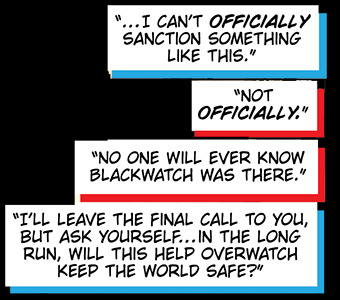
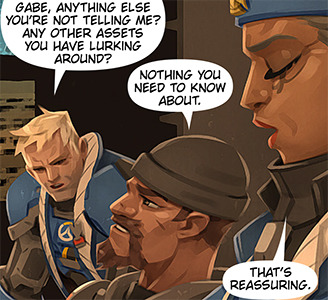


There are two mentions of Blackwatch in Storm Rising and they at first appear contradictory. It’s not clear if Blackwatch is still under suspension or not. It is possible that they are continuing to operate without official sanction, ala Retribution and Uprising. There are also multiple interactions regarding Commander Morrison being under pressure to disband the Strike Team (this might have stemmed from the incident with Reinhardt) and the possible reassignment of Overwatch, so it’s safe to say the entire organization is under threat at this time.
Storm Rising is also the culmination of gray area events started when Morrison first allowed Blackwatch Commander Reyes to undertake Retribution without official sanction. During Uprising, Morrison finds out that Reyes is still utilizing Blackwatch agents without official sanction and while under suspension. Storm Rising is the first mission during which Morrison and Reyes are arguing about the fate of Overwatch, but notably the Overwatch Strike Team is still happy to use Blackwatch intel.
4) Humanitarian Crisis in Egypt


The Bastet short story was the most recent touch on the issues in Egypt, but they have been previously mentioned in Mission Statement, Are You With Us, and Uprising.
Let’s recap our Egypt timeline real quick:
2066: Overwatch intervenes in Cairo, Egypt and shuts down the Anubis Project, quarantining the A.I. This intervention ultimately decimates Egypt’s population, suggesting Anubis’s original purpose was infrastructure-related.
2069: Mercy mentions the ongoing humanitarian crisis in Egypt. At the same time, Director Petras orders an investigation into an incident in Cairo (it’s not exactly clear what the incident is, but directly above the headline about the investigation there are some Widowmaker scope views and another headline that says “Overwatch official murdered”).
2070 - Storm Rising: Overwatch requests a medical assessment from Mercy on the Egyptian crisis.
2070 - Doomfist Origin Story: The Strike Team, minus Mercy, deploys to capture Doomfist in Singapore.
It seems likely that Mercy was deployed to Egypt while the rest of the Strike Team went to Singapore. This may also explain why Mercy survived the destruction of the Overwatch HQ in Switzerland. When Mercy appears in Recall years later, her location is near Egypt in the Middle East. Ana notes Mercy’s proximity in Bastet, and if the follow-up animation Bastet Rises is to be believed, Ana ultimately brings Soldier 76 to Mercy.
Where does this put us in terms of future story? I’m not sure. Maybe the dialogue in Storm Rising was just ensuring all the Egypt threads are connected, but why develop it at all if there is no payoff? There is one other point about Egypt that’s notable: it’s the location of the meeting between Doomfist and the Mystery Omnic in Storm Rising.
5) Mystery Omnic
I already wrote a whole post about this guy so I’ll just link that - https://thebiblesalesman.tumblr.com/post/184262814469/3-popular-storm-rising-mystery-omnic-mo-theories
I would be surprised if MO turned out to be something other than a Null Sector operative, though him meeting Doomfist in Egypt with all the emphasis on Egypt in other recent media is making me shake in my boots a little...
6) Sojourn
Sojourn is a veteran Overwatch official with the rank of Captain. She has an extensively modified cyborg body. Michael Chu cited her as existing in a historical photo where only her arms appear mechanical, but additional modification happened between then and the time of Storm Rising (McCree, Mercy, and Pharah are all in the photo as well, so the additional mods must have taken place in the latter part of Overwatch’s history). Sojourn is the one who had the idea to target Maximilien in the first place. While we know quite a bit about her personality from various mission interactions, we don’t know much about her history at this point. She appears on one of the agent IDs in Recall.
7) Maximilien
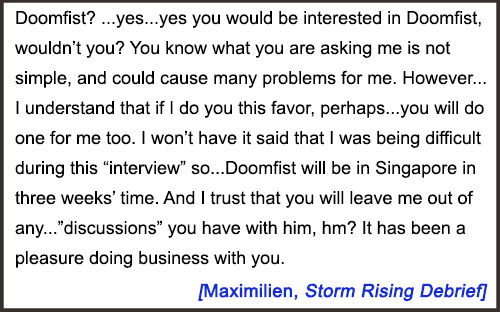
The Storm Rising teaser sees Sojourn refer to Maximilien as “Doomfist’s accountant”. In Retribution, Commander Reyes could barely think of Maximilien’s name when asked about known Talon operatives. In Masquerade Max told Doomfist “we have history”, so it may be that he was literally Doomfist’s personal accountant before entering Talon. Doomfist is the heir to a prosthetic technologies company, so he does have finances to manage (I wonder if his company provided parts or technical guidance for any of Overwatch’s cyborgs?).
Maximilien sold out his boss at the end of Storm Rising, leading to Doomfist being jailed and his plans being put on hold for 6 years. When the two of them meet again in Masquerade, Doomfist notes he doesn’t trust anyone, but Maximilien’s betrayal isn’t specifically addressed. A few pages of Masquerade are dedicated to rooting out Talon members who have strayed from Doomfist’s ideals, but Maximilien is left with a spot at the table.
One of Doomfist’s targets is Vialli, who became obsessed with profit over the organization’s larger goals. In Storm Rising Maximilien certainly seems like the same archetype as Vialli- even the Strike Team members note his “expensive tastes”. But apparently money is not the only thing on his mind. Maximilien notes in the comic that he respects Doomfist as “a man with vision”. What he hopes to gain out of Doomfist’s human-omnic war still isn’t particularly clear.
It would be very poor of me to go through Maximilien’s section and not mention again that he has Twelfth Night fanfiction (or maybe it’s a chat roleplay?) on his computer in Don Rumbotico. It’s still there in the modern Havana map, so feel free to go ogle if you wish.
66 notes
·
View notes
Text
Dragon Ball Z 042
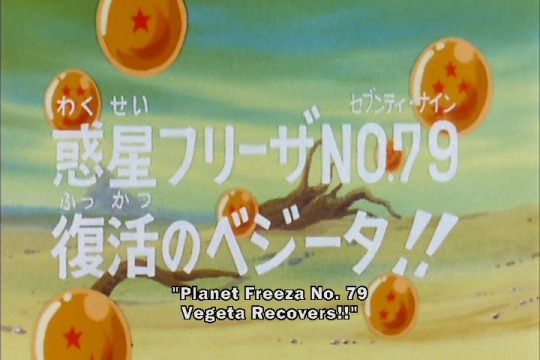
When I saw Resurrection F in the theater, they opened with this really long video before the movie, which included a trivia section. One of the questions was how many planets did Frieza have in his empire, and the correct response was “at least 79″, which I assume was based on the name of the planet in this episode title. It bugged me to think that anyone would assume #79 was one of the last planets, simply because no higher numbers were ever established, but if Frieza #79 really was the homeworld of the orphan refugees in episode 40, then I guess it makes sense for it to have been conquered fairly recently, so it probably would be one of the last ones.
And seventy-nine planets is a lot. I tend to think of fictional galaxies as having more inhabited worlds. DC Comics has the Green Lantern Corps, which boasts 3600 sectors of the universe, with at least one inhabited planet in each one, but probably a lot more than that. Star Wars and Star Trek usually don’t bother with numbers, but the standing rule in both seems to be that a writer can introduce a new planet as they please, because there’s so many out there that one more won’t affect much. I seem to remember Count Dooku referring to “ten thousand systems” joining his cause, implying that there would be at least that many who would oppose him. So it seemed to me that if Frieza is as big a big shot as everyone says, he ought to control a much larger number of planets than 79.
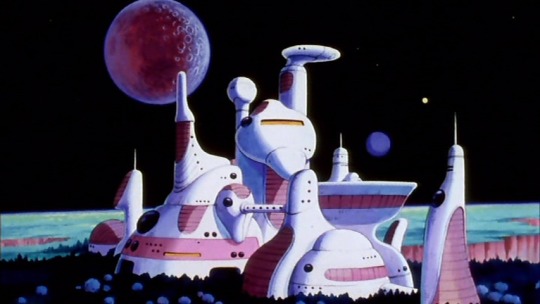
On the other hand, Frieza’s supremacy is based entirely on his person, so it really doesn’t matter how many planets he directly controls, since he can only be on one at a time. Owning a thousand planets wouldn’t change much for him. The Dragon Ball franchise seems to go for a minimalist approach anyway. Dragon Ball Super stated that there were fewer than thirty planets with intelligent life, which makes no sense if Frieza has more than twice as many planets under his control. Still, the tendency always seems to be towards low numbers. I like to think of interstellar empires as having hundreds of provincial worlds, but admittedly I have no way of comprehending that sort of scale. Seventy-nine is probably plenty.
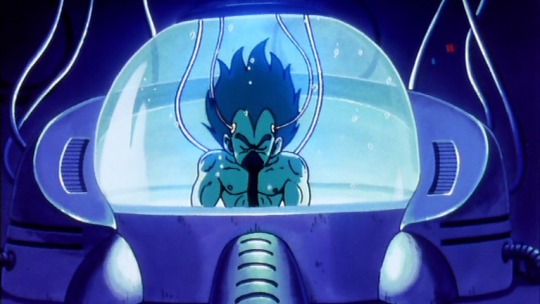
So this is the episode where Vegeta finally recovers from his injuries. Well, keep waiting, because he’s still in the damn healing tank.

Meanwhile, Goku gets so restless that he tries to sneak out of the hospital in the middle of the night, and then he falls down the stairs.
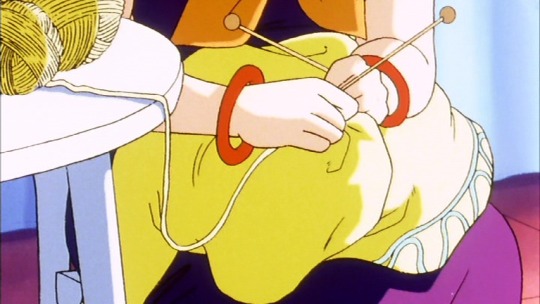
While this is going on, Chi-Chi is still knitting, and she seems to have expanded the sweater she was working on.

As for Bulma, Krillin, and Gohan, they’re hunting down the last four Dragon Balls the need to wish their dead friends back to life. The only problem is that they’re not on Planet Namek at all. So how are they finding Dragon Balls, and why are there Namekians here?
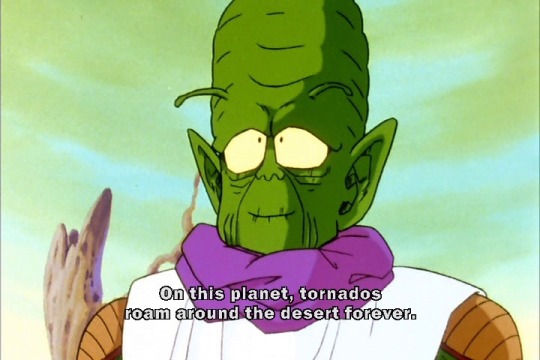
This time, Dr. Lychee accompanies the gang, and when they find a Dragon Ball in a tornado, Lychee helpfully explains that the tornadoes on this planet never die out, so they can’t just wait to get the Dragon Ball later.

So Gohan jumps in and goes after it, because he is his father’s son after all.

I’m confused, because Gohan got the three-star ball here, but I’m pretty sure the three-star ball was mentioned in the title of the previous episode, so I guess they didn’t actually find that one last time. Huh.

Meanwhile, Goku’s gone out to the middle of nowhere to train in spite of his injuries.

“I’m Son Goku! Welcome to Jackass!”
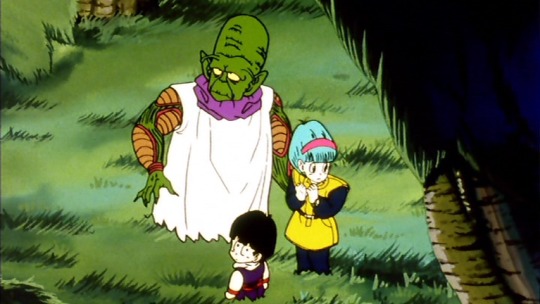

On ““““Namek”“““ the gang looks for a Dragon Ball in a forest, only to discover that the foliae is actually the feathers of an enormous bird. You could probably do a seven-book fantasy cycle around a concept like this, but Dragon Ball Z just tossed it out in filler episode. This is one of the reasons I don’t like GT, by the way. The first arc of Dragon Ball GT looks and feels a lot like this Fake Namek arc, but it somehow manages to do less with more. The GT crew had to search multiple planets for the Black Star Dragon Balls, and none of them had anything nearly as creative as forest-sized birds.

As for Goku’s “traning”, it doesn’t go well, because he’s so badly hurt. I don’t really understand the premise here. Goku seems to be able to walk and fly just fine, but whenever he tries to exert his super powers, he siezes up and has trouble. That’s fine and all, but if that’s what’s wrong with him, why all the bandages? Vegeta broke at least some of his bones, so I don’t see how he made it this far on his own.

As Goku struggles to save himself from falling, he flashes back to Vegeta’s parting words. He plans to return to Earth to finish what he started, and Goku let him go because he planned to be ready for him. Only he’s not ready, is he? He can’t even move well in the shape he’s in.

That gets him fired up, and he seems to find a newfound strength.

Back on Fake Namek, the gang tracks the next Dragon Ball to a big castle.
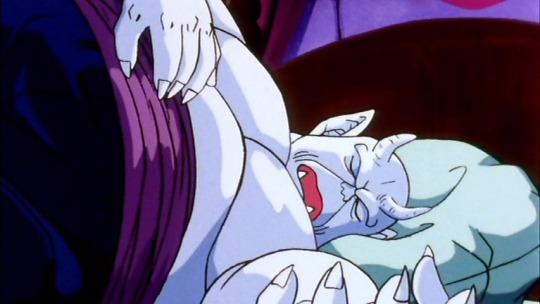
There’s a giant inside, but he’s asleep, so it’s safe for the moment. The bigger problem is that they can’t spot the Dragon Ball, even though the radar says it’s here.

Then this giant snake pops up. I love this snake. I never see this guy coming, because why would anybody sleep with a live snake in their bed? Where did this giant even find a snake this big? Also, he looks right at our heroes and just sort of slithers away.

With nothing better to do, the gang looks through the giant’s stuff. Why would he have an earth-style model plane? Is “AKIYAMA” a reference to Akira Toriyama? Probably.
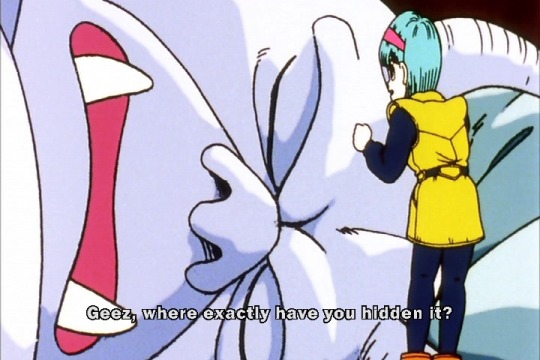
Bulma walks right up to the giant’s face and asks him where the Dragon Ball is.

Then the snake comes back and he’s all like “Uh, excuse you, people are trying to sleep.”

I love the way he side-eyes Bulma as he moves on. Snakey is awesome.

Finally, the giant turns over, revealing the Dragon Ball embedded in an earring. Why would he sleep with that in his ear? Also, why does it take all three of them to pull the Dragon Ball out? Krillin ought to be able to Kienzan the earring apart easily. For that matter, there should be a fastener or something that they could just unhook.

After a tense moment, they managed to pull the ball loose without waking up the giant, and Bulma whispers “Saaaaaaffffffe” which is really cute. This screencap can’t do it justice.
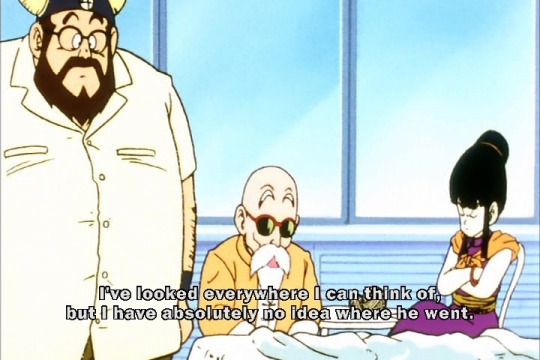
Meanwhile, everyone knows Goku’s gone missing, and Chi-Chi’s pissed.


Roshi tries to defend Goku’s actions, but Chi-Chi won’t have it. Bad enough she has to worry about Gohan, but Goku insists on manufacturing danger for himself. She’s right, Goku’s kind of being a dick about this.

Wait, is Chi-Chi saying that she’s gonna blow her nose in his sweater?

Hey remember how that giant didn’t wake up? Well it didn’t last long, because he’s awake now, and pissed.
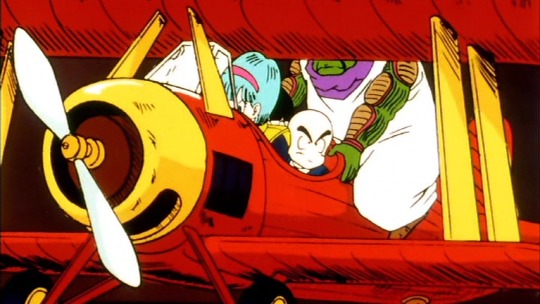
For some reason, Bulma insists on fleeng to safety in the model plane in the giant’s bedroom. Why would it work if it’s just a toy?

Krillin and Gohan fight the giant to buy Bulma some time, but their attacks only damage the giant without actually slowing him down. Notice how they’re flying around while they wait for Bulma to fly them out of danger.

Well, whatever, Bulma gets the plane going and they all clear out, with the Dragon Balls in hand.

Bulma takes credit for the whole enterprise. Bulma’s pretty awesome.


Krillin looks back and sees that the castle has vanished, and when he checks again, it’s back, but it’s a completely different castle. He doesn’t get it.
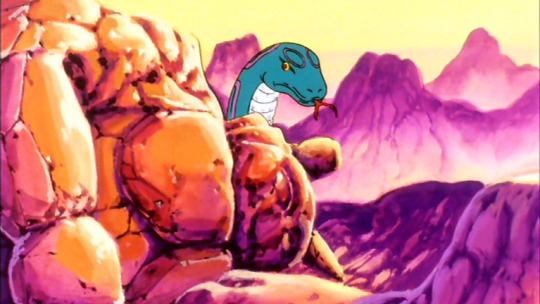
Then we see the site where the castle had been, and there’s a rock formation that looks a lot like that giant. But Snakey is real, apparently. This is the first big clue that Things Are Not What They Seem.

Back on Earth, Goku’s flying around all happy and stuff. Okay, is he hurt or not? I honestly can’t tell if he’s only staying in the hospital because Chi-Chi is making him stay in the hospital, or if he’s just working through the pain.
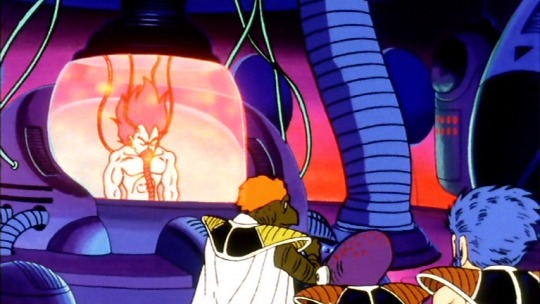
On Planet Frieza No. 79, something is happening in Vegeta’s healng tank. I guess the doctor added some therapeutic disco lights to his healing fluid.
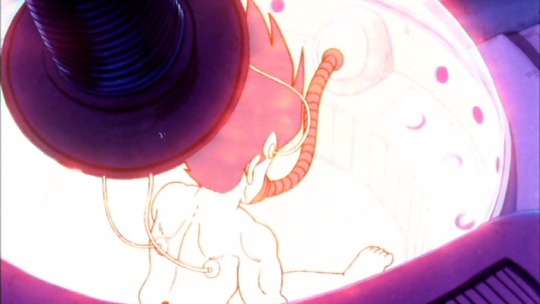
I keep forgetting that you have to sit in the tank like a big naked baby in a high chair. There’s a reason they never show it from this angle, and that’s because it looks really stupid. I just naturally assumed they float upright in these things, because that’s what Luke Skywalker did in Empire Strikes Back.
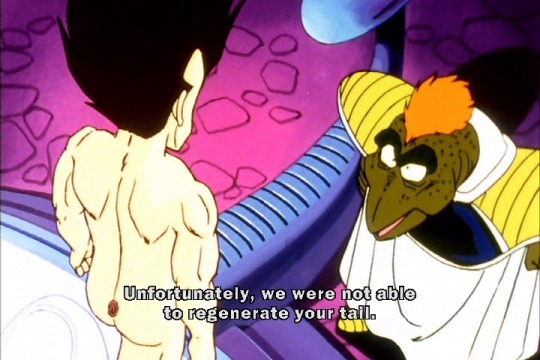
Anyway, Vegeta finally gets out of the tank, and his injuries are healed, all except for his tail, which was cut off by Yajirobe. Vegeta doesn’t care, since he believes it’ll grow back on its own eventually. In the dub, he just says that it doesn’t matter because he won’t be needing it, which is probably more accurate, since we never see the tail again.
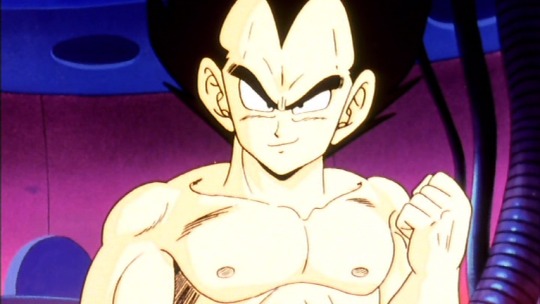
The important thing is that his right eye is working again, and his nipples are in tip-top condition. Tumblr’s going to flag this one, aren’t they?
I notice Vegeta’s neck is a lot thicker than it was when he first appeared in the Saiyans Saga. I’d have to go back and look, but I’m guessing this is when he finally completed the transition from skinny Vegeta to swol Vegeta. Goku had beetter watch out, because Vegeta’s gonna hit him with his neck as hard as he can...
#dragon ball#2019dbliveblog#bulma#gohan#krillin#lychee#goku#vegeta#chi chi#ox king#master roshi#snakey#fake namek#namek saga
21 notes
·
View notes
Text
since a big part of crossthicc is hype pregnancy/mass reproduction and all the fun stuff of having broodmothers for main characters - birthing numbers in the hundreds or thousands, modifying the young to be entire new species, making them genetically unrelated to themselves or their creator so they can reproduce normally - i had a worldbuilding thought: what if this is ncessecary to some degree?
it follows the vibe of the setting so far; the multiverse of Crossthicc is a DANGEROUS place. Rampaging armies of fiends periodically get spit out from magical hole sin the universe, laying waste to all they encounter. Pokemon rampage as mindlessly agonized kaiju, natural disasters that yell a lot. Warlords, conquerers, slavetakers ad corporate dominators are an ever present threat EVERYWHERE you go. And that’s not even getting into the giant monsters that show up everywhere, or the risk of some domineering woman growing larger and larger with her political and magical powers until she is a giantess and her appetite causes her to devour her armies and then her very world, the metaphor of conquest becoming literal as she EATS her planet and evolves to a titan of greed and narcissism.
Prior to the main events of the AU and its stories, death tolls were catastrophically high every where you go; most civilizations collapsed in the cataclysm of ancient days, many species outright went extinct in the chaos that followed, and countless more societies have risen up and collapsed since. And the multiverse is SO dangerous that all these disasters, wars and monsters destroy EVERYTHING in their sight. Lives are very brief, and people die fast, reproducig quickly just to keep society alive. And that’s not even bringing into the possibility of hyper voracious appetites from women who develop the more destructive kinds of powers.
The multiverse wasn’t half-empty, it had a huge crack in it and popluation number were constantly dropping.
That is, until the coming of the Endowed Fleet, the predominance of the Ringer empires, and the security brought by the Cobalt Stingers, as well as the other factions and interstellar groups produced by their wake.
When Sierra woke up the Matriatrix and devised its powers to imbue others with enormous fertility, limitless child-bearing potential and the power to grow stronger through it, she rammed this death toll right in its face and turned it around; she, her allies, friends and those who have the same fertility powers can produce so many children they can populate entire worlds, all on their own, and with the power from it, they and their offspring can take down those threats with a single blow.
Hyper pregnancy powers (like having babies by the thousands, growing them EXTREMELY fast and getting a power boost for every child born) are now increasingly common, with mods to enable them nearly universal. Even random unpowered characters are likely to be superhumanly fertile or virile, and so populations explode overnight, filling up a multiverse largely depopulated and empty.
this fits with the trend of Crossthicc’s overall vibe of an age of excitement and adventure, rising out of a seemingly endless era of darkness!
4 notes
·
View notes
Text
Favorite Books of 2018
I read a lot of books in 2018. Here are my favorites (not counting books I re-read), in basically no order. (But actually kind of an order.)
22. Going Rogue, Drew Hayes
Going Rogue is the third book in Drew Hayes’s Spells, Swords, and Stealth series. The series is told in two parts: it follows a group of people playing a Dungeons & Dragons-style role-playing game and a group of non-playable characters in the world of said game. The thrust of the story is on the group of NPCs, which unfolds as a typical fantasy adventure. It’s got a straightforward quest narrative, an adventuring party (turned found family), and impossible odds. As the stories progress, the players begin to sense that the game has its own agency and the characters begin to sense that there may be someone controlling their world. But mostly it’s a fun, self-aware take on a typical fantasy adventure that toys with fantasy tropes.
21. Americanah, Chimamanda Ngozi Adichie
I steeled myself for dense literary fiction when I cracked open Americanah, the story of Ifemelu, a Nigerian girl who moves to America and wrestles with race and identity. But that was all for naught because Americanah was one of the easiest reads of the year. The writing is breezy, and the story is funny and brisk. It dissects race and culture in America both by showing (Ifemelu’s struggles to define herself in a new country) and telling (Ifemelu’s hilarious blog posts). Chimamanda Ngozi Adichie seems to have perfected the art of delivering dense observations in delightful, consumer-friendly prose. Old white dude authors should probably take note.
20. What If It’s Us, Becky Albertalli & Adam Silvera
If I’m going to read a romance, I want it to be light, fluffy, gay, and conflict-free. And that’s exactly what What If It’s Us delivers. The book begins with a meet cute: while mailing a box of his ex-boyfriend’s stuff, Ben bumps into Arthur at the post office. Arthur and Ben are both appropriately awkward and endearing, bumbling and pawing their way through a relationship as only teenagers can. Every character is essentially kind and caring. There are no villains or bullies, no one gets ostracized or beaten, no one dies. The tension mostly stems from the fact that Arthur is only in the city for the summer, which only barely counts as a conflict. And while the universe of the story may be unrealistically polished, their relationship is refreshingly imperfect. Adam Silvera and Becky Albertalli are telling a story of young love, not necessarily true love.
19. The Collapsing Empire / The Consuming Fire, John Scalzi
John Scalzi built an astoundingly engrossing world in The Collapsing Empire. The human race has colonized far flung planets with the help of the Flow system, naturally occurring pathways between various planets across the universe that allows otherwise impossible interstellar travel. The Collapsing Empire follows the sharp, sarcastic Cardenia Wu, the newly crowned empress, and sweet, in-over-his-head Marce Claremont, a Flow physicist in far-flung End who has discovered something off with the Flow. It’s got a roiling pace, packed with space battles, political jockeying, and a whole host of delightful characters. It’s one of those audiobooks (narrated by Wil Wheaton) that was so compulsively listenable that I ended up taking long, meandering walks just to hear what happened next.
18. The Shell Collector, Anthony Doerr
Anthony Doerr’s writing is incredible. His sentences all feel divined from the ether. And the short story is the perfect vehicle for that writing, lasting just long enough to build an atmospheric world. Most of the stories are tinged with a little magical realism, used mostly to underscore the unique, grounded humanity of his characters. The collection dives into the histories of people who are in various degrees removed from society and intertwined with nature. But the ultimate thesis, refreshingly, is not about the corruption of society, but rather the inherent value of people.
17. Giovanni’s Room, James Baldwin
I don’t know that I have anything new or interesting to say about James Baldwin’s Giovanni’s Room. A story about desire, and maybe love, between David and Giovanni, every word of that book is filled with intense, crushing emotion desperately crashing onto the pages. It’s about love and sexuality, told in an intimate-verging-on-claustrophobic manner. It’s powerful and interminably depressing and beautiful and devastating. But it’s not devastating because it’s gay, it’s just both devastating and gay.
16. Goodbye, Vitamin, Rachel Khong
Goodbye, Vitamin opens with the main character, Ruth, going through a breakup and dealing with early signs of her father’s Alzheimer’s disease. And somehow, Goodbye, Vitamin is also fun, funny, and heart-warming. The book is sunny and endearing, even as Ruth herself struggles with caring for her father and finding her own identity. Most things described as quirky may be better described as annoying, but there truly is no better word for this book’s sensibility than quirky. The specificity of the descriptions and the cleverness of the wordplay make for a delightful, sometimes deeply poignant, read.
15. Less, Andrew Sean Greer
In many ways, Less shares beats with the incredibly overdone, deeply uninteresting novel about a middle-aged white guy who goes through a midlife crisis and suffers the pain of his own brilliance. Indeed, Less follows Arthur Less as he hits fifty, gets invited to his ex’s wedding, and then travels around the world to avoid confronting any of his problems. But Less is decidedly different: it’s gay. Which means it’s funnier, sharper, and drastically more self-aware. Arthur Less - and Andrew Sean Greer - recognizes the absurdity of his disproportionate reaction to relatively minor problems. He has no delusions of grandeur. He’s not on a journey to unlock his inner genius, just a journey to maybe buy a new jacket and have a fling or two. It’s delightful and funny and warm even as it pretends not to be.
14. More Happy Than Not, Adam Silvera
The devastation of More Happy Than Not cuts in sharp pains and deep gashes. The tragic turns - and in a book about a teenage kid who considers a science fiction equivalent of gay conversion therapy there are many - come as punches to the face, not as lingering aches. And yet, the book doesn’t feel punishing to read. Adam Silvera derives no pleasure from Aaron’s, the aforementioned teen, suffering and carefully builds the foundation of Aaron’s character on his triumphs and joys. Aaron’s life is vibrant and bristling with possibility, streaked, but not consumed, by pain. More Happy Than Not is meticulously plotted and paced, with a few moments of genuine surprise. As always, Adam Silvera writes about tragedy in an entirely uncynical way, with a deep well of generosity for his characters.
13. Witchmark, C.L. Polk
In many ways, Witchmark feels like the book I spent this entire year trying to find. Witchmark takes place in a pseudo-historical early 20th century England-style setting, in the throes of some capital-W War. Most of the book is styled as a mystery: Miles, a former army doctor, and Tristan, a mysterious outsider, track down clues and chase leads to find a murderer. And, of course, maybe they fall in love along the way. And, oh yeah, Miles is a witch. Oh and also, maybe there’s some royal family drama happening as well. And maybe also some government conspiracies. And also maybe a much larger mystery that involves all of the above. There’s magic and romance and mystery and intrigue and action, and every part of it is completely satisfying. Especially if you’re the type of person who would like to read a scene in which said army doctor needs help undressing because he broke his wrist, and luckily there’s (literally magically) handsome mystery man there to help him!!! (Listen, I never said this was particularly profound literature.) But like, five stars.
12. Mr. Penumbra’s 24-Hour Bookstore / Sourdough, Robin Sloan
If you want a cozy, feel-good novel that has just the slightest dash of magic, then pick up a Robin Sloan book. Both Mr. Penumbra’s 24-Hour Bookstore and Sourdough read as relaxing balms to help soothe aches brought on by the disaster fire of reality. In both books, a young twenty-something attempting to figure out their life discovers a niche world (book collecting and bread baking) and gets swept up in a fantastical mystery. They’re breezy, warm, and brimming with genuine affection and curiosity for the subjects at their centers. Sloan’s writing is incredibly sensory; you can taste the bread and smell the books. They have that Great British Bake Off quality to them: impossibly compelling despite low stakes and uniform pleasantness.
11. Little Fires Everywhere, Celeste Ng
Celeste Ng’s second novel is a careful study of privilege of all sorts, and an especially incisive look into whiteness. Little Fires Everywhere takes place in Shaker Heights, Ohio, a progressive slice of white suburbia. At the book’s center are the Richardsons, a well-off white family who are the types of people that may tell you that they don’t see race--in part because everyone they see is also white. Things get shaken up when Mia Warren and her daughter Pearl arrive in town, marked as strange by their relative lack of wealth, and marked as even stranger by their lack of shame about it. Each sentence is beautifully written, and each paragraph immaculately constructed. But honestly, the book is best summed up as: this is some white people nonsense.
10. The Lymond Chronicles (#1-6), Dorothy Dunnett
The Lymond Chronicles books are both the most high brow and most low brow books I read this year. They are densely written and plotted, with an inexhaustible supply of names for characters and teeming with minute details that almost all portend some future event or revelation. But they’re also chock-full of soap opera-style twists and tropes, aimed to quench your id’s every desire. All this makes for books that demand a lot, but then pay off with hilarious jokes, action sequences that convey more physicality and movement than most movies, and ridiculous third act reveals that are so incredibly satisfying. And like, on a selfish level, it’s also real satisfying to read about people falling in love with and then aggressively berating Francis Crawford for three thousand pages. (He deserves it.)
9. My Life as a Goddess, Guy Branum
I read, or rather listen to, tons of memoirs - by comedians, actors, politicians, and writers. And Guy Branum’s My Life as a Goddess is easily my favorite of the year. Branum incisively writes about growing up as a gay kid in truly the-middle-of-nowhere California, touching on issues of masculinity, sexuality, class, body image, and education. Unsurprisingly, My Life as a Goddess is hilarious, chock-full of jokes and witty observations. More surprisingly, My Life as a Goddess is also deeply emotional, especially as Branum writes about his relationship as his father. Even more surprisingly, My Life as a Goddess is weirdly informative about a very specific slice of Canadian history. I cannot recommend the audiobook of this enough, as Guy Branum’s narration is smart, funny, and winning.
8. All the Light We Cannot See, Anthony Doerr
Does anyone really want to read a Pulitzer Prize winning literary fiction novel written by some white dude about World War II half from the point of view of a goddamn Nazi? No. No one wants to read that. Except, maybe I do. Because that’s exactly what All the Light We Cannot See is, and man is it a true revelation. The sheer humanity that Doerr imparts in his story creates a profoundly moving story, about goodness and cruelty and the indiscriminate destruction of war. The events of the story are uniformly bleak, as expected in a World War II novel, and yet the book’s tone feels decidedly hopeful, hungry to extract optimism from human persistence. It’s a stunningly written book that lays bare the complexities of people and the horrors of war.
7. Bad Blood, John Carreyrou
Bad Blood was truly the most unbelievable story I read this year. Wizards? Aliens? Time travel? All relatively believable compared to the intense, densely plotted, thrilling tale that unravels in Bad Blood, made all the more incredible by its truth. Bad Blood tells the story of Theranos, a Silicon Valley startup that claimed to be revolutionizing blood testing, and its founder Elizabeth Holmes, once described on magazine covers as “the next Steve Jobs.” John Carreyrou, the author, was the journalist who first broke the story of Theranos’s rampant fraud, and he stitches together a coherent, mesmerizing narrative from first-hand accounts of Theranos employees. Elizabeth Holmes is a fascinating antagonist, an ambitious, callous, maybe sociopath. The story is exciting and frustrating and will make you have even less faith in rich, powerful white people. But because this is non-fiction, the entire time you know that Elizabeth Holmes is eventually going to end up being charged with numerous federal crimes. A truly satisfying ending.
6. Hyperbole and a Half, Allie Brosh
Allie Brosh didn’t invent the internet, but she at least has as much claim to modern internet culture as any other individual. Hyperbole and a Half is a collection of her best blog posts, with some additional, equally hilarious, stories thrown in. I hadn’t revisited her blog in years, and so it was striking just how little her style has aged. In a time where internet memes have life spans measured in hours, Hyperbole and a Half feels fresh nearly a decade later. The influence of her style and perspective on the internet is far-reaching. From the hilarious (her distinctively drawn self-rendering triumphantly declaring “CLEAN ALL THE THINGS” while holding a broom) to the insightful (her two-part essay on the amorphous gray muck of depression), her stories all feel as though they could be the origin story for any piece of internet ephemera. Hyperbole and a Half is at times farcical, at times poignant, and always raucously funny.
5. Shades of Magic (#1-3), V.E. Schwab
The Shades of Magic series (A Darker Shade of Magic, A Gathering of Shadows, and A Conjuring of Light) is the perfect fantasy adventure: the characters are imminently rootable, the world is seeped in magic, and the plot is intoxicating. The books are set in London, or Londons, rather. There are four parallel Londons, which have embraced, rejected, or surrendered to magic to varying degrees. Our protagonist, Kell, is one of the few with the ability to travel between the different Londons. And, well, hijinks ensue. Dark, sprawling, brutal, violent, life-consuming hijinks.
The Shades of Magic series is unburdened by its worldbuilding; V.E. Schwab could probably teach a semester’s worth of history lessons on her world, but does not feel the need show that off in the books themselves. They’re books to be devoured, not dissected. But it’s the characters that make the series so engrossing. Everyone is an archetype-a street-worn thief, a charming prince-but so well-drawn and understood that every character moment sparkles. And the central relationship of the book, between Kell and his brother Rhy, felt as though it was perhaps extracted directly from my brain. Kell is stoic, burdened by responsibility but determined to protect. Rhy, the aforementioned charming prince, injects Kell’s life with mischief and levity, and they’re so fundamentally dedicated to each other that it hurts. If a bunch of well-meaning idiots trying to save the world with magic is your thing, A Darker Shade of Magic may be the series for you.
4. Everything I Never Told You, Celeste Ng
If you thought a quiet, contained rumination on race, gender, nationality, and culture couldn’t also be a compelling, tense page-turner, let me introduce you to Everything I Never Told You. Everything I Never Told You is nothing short of literary alchemy. It begins with the death of Lydia, the model daughter of the Lee family--and, really, the model daughter of 1970s America. The book unravels the mystery of Lydia’s death, told through the vignettes from the lives of the Lee family members.
Celeste Ng is a master at using a paragraph to describe years of a character’s history and decades of American society all at once. Her characters are specific and sharply drawn, rooted deeply in their time and environment. Lydia, with a Chinese father and a white mother, is mixed race (a term not added to the U.S. Census until 2000)--“one of only two Orientals” at her school. The other, her brother Nathan, has learned to live in Lydia’s shadow in their parents’ mind’s eye. Marilyn, Lydia’s mother, had her own ambitions sidelined by family. With a deft, heartfelt touch, Everything I Never Told You viscerally conveys their regrets for the words left unsaid and lives left unlived.
3. History Is All You Left Me, Adam Silvera
As this list makes clear, I loved a lot of Adam Silvera this year, and History Is All You Left Me stands out as my favorite. In dual timelines, History Is All You Left Me tells the story of Griffin after and up to the accident in which his ex-boyfriend Theo dies unexpectedly. And so, yes, the book is soaked in grief and loss. And, yes, it’s devastating and aching. But it’s also incredibly kind and empathetic. The characters are teenagers and make the choices of teenagers. Their actions are messy and rash and stupid, and Silvera leans into that, landing more than one self-inflicted heart-wrenching blow. But Silvera is also unfailingly patient with teenagers and understands their resilience; he lets his characters make mistakes and has faith that they will survive. And so the book is heavy, but optimistic. A refreshing reprieve from the gratuitous suffering and bleakness that tortures so much LGBT-themed fiction. History Is All You Left Me is the most affecting book I read all year, and it still lingers in my bones. But the impression it has left is of life, not loss.
2. An American Sickness, Elisabeth Rosenthal
I bristle when someone describes a book as “important.” It always seems patronizing and self-serving, and my natural contrarian kicks in. I get it, you want to tell everyone how well-read or socially conscious you are because you read an “important” book. So it is with eyes wide open, and more than a twinge of self-loathing, that I say An American Sickness is an important book. It feels like essential reading, certainly for anyone trying to affect American healthcare policy, and at the very least useful for anyone who ever has to deal with the American healthcare system. It will make you angry and frustrated, but hopefully it will also arm you with information.
An American Sickness is broken up into two distinct parts: the first half lays out the issues with the current healthcare system, including how it came to be, and the second half presents solutions. Dr. Elisabeth Rosenthal writes accessibly about potentially dry, dense subject matter. The book’s purpose is not to exhaustively detail the history of healthcare, but to better equip the average person to navigate the system. Dr. Rosenthal provides anecdotes to anchor the matter in tangible issues and gives just enough context to sketch the motivations of the various actors - doctors, hospitals, insurers, pharma companies, etc. She presents solutions from two perspectives: (1) changing healthcare policy as a whole, and (2) navigating the system as an individual. In a methodical, step-by-step manner, the book explains concrete things a regular person can look out for, questions they can ask, and actions they can take to avoid--or challenge--exorbitant medical bills. There’s literally an appendix with fill-in-the-blank form letters to use to request billing information and challenge bills. You don’t have to read this book, but I want you to.
1. Chemistry, Weike Wang
Sometimes a book is so intimately catered to you it’s as if the author waded through your subconscious, fished out the tangled threads of your thoughts, and then wove them into a tapestry that displayed every single one of your hopes, dreams, and aspirations. For me, that book is Chemistry. Chemistry follows an unnamed Asian American protagonist who is discontented with her current situation: her long-term boyfriend, her Chemistry PhD program, and her relationship with her parents. And the novel unfolds as she comes to terms with that discontentment.
The economy of Weike Wang’s writing is spellbinding. She uses words so efficiently and so cleverly to craft sentences that seem fundamental. On seemingly every page, there was a new observation that felt so obviously true that I was surprised I had never read those exact words before. The book is filled with jokes, driven by the protagonist’s wry sarcasm and gentle disdain for things and people generally. The whole thing is somehow both simple and complex, an easily digestible read with a deceptively complex flavor. There are no splashy revelations or sudden tragedies, only hard-earned emotional truths and the realities of getting by. Chemistry nails the general spirit of just attempting to function as a normal human person in 2018.
8 notes
·
View notes
Note
⭐!
The two umbrali were holding hands still when the interstellar liner left the barge and they watched their starry home fade to white in Jenya sunshine. (By that time they were more than friends–to find a name for what they were, one had to turn to poetry.) They let go, of course, when the bell rang; the power couple they were sworn to were en route to their new proving ground in the Rings, where several noble ladies were considering investing with them.
“It’s cold, out here in space,” her soft clear voice would come up from the bunk beneath in the lower decks. “I’d forgotten how cold it was. Are you cold, senneta?”
And she’d say to her, “Come on up here already, don’t make a wretch of yourself.”
(The bunk gave space enough for them to lie shoulder to shoulder, but they would face each other anyway, veils rippling minutely in each other’s breath, fingers clasped over fingers between the warmth of their two bodies.)
“Back in programming,” the girl said to her on one of those too-brief nights, “I met a secondhand who’d worked with units from the invention lots.”
“No–you can’t have,” she gasped. “They’d be long gone by now.”
“She was old, and knew them when she was young. Do you know what they told her?”
These questions always made her want to squirm, but she held still. Held breath. (Held her hand.)
“The clone-makers didn’t make the first seed-cores. There were no lux yet for them to come from. They came from astraeas, proper ones I mean.”
“Now don’t go telling your awful tales!” She pushed her double’s shoulders slightly back across the sheet. One of them had to keep them true in the orbits, and that was her of course, the elder. (In the back of her mind, it made a lot of sense. You can’t make something out of nothing.)
“My awful tales are always true, senneta. You know how sorry I am that they are. You bear it to be part of something beautiful. But nothing’s beautiful enough to make it right. Lux are manufactured to suffer so everyone else can have it good.”
With all her strength, she turned over and away, so she wouldn’t have to look her in the absence of her face. “Our ladies suffer too, don’t they? They work hard. They stay awake all night–and–and worry so much about impressing all those people–”
“And if they fail, they’ll lose their ship and their money. But we’ll lose our honor and our homes, senneta. They have sisters to go back to. Shamed, but they can go back.”
“So can we.”
“Yeah, to the extraction queue. Nobody wants an ex-umbralis for a factory line. Face it, it’s this or nothing.”
(She wanted to say, so what are you going to do about it, tough tank? But to be honest she was scared of the answer.)
“What are you saying then, about the invention lots? That the clone-makers killed people?”
“Not with their own hands. There was a war, something about a shipyard. The old tribes on this planet betrayed the aula’s word. It was way off in the Soneto quad…” She paused. (She knew what she was waiting for, and turned back over to face her.) “Ashtiva,” she said, breathing out the name–the first time–that so lent itself to sighs. “That’s where we’re from.”
“I’m from Lapidary Street Biochem,” she couldn’t help but smirk, though her smirk was full of warmth.
“Originally though. The raw bit that got you started.”
“What’s it matter, what planet it came from? It’s just deuterium and carbon. Stuff the universe is made of. I was on spectrogram duty in the factory, you can’t dazzle me as easy as a clientela,” she teased desperately–trying to drag them off the precipice of knowledge, a place she already spent, she worried, too much time. Her lady had her arranging steel spans into ever-larger squares, testing which would conduct charges at the required strength. Sometimes, when the great minds of the new era had gone to bed refusing her assistance in frustration, she kept it up (unshaken by her flagging wakefulness, pushed ahead by something not unlike the static in the air between her hand and another hand just like it).
(Maybe it all came down in the end to forms of electricity.)
@onwardmotley Boy did I worry about this one. Even though I'd say the thing I'm interested in as a writer is the emotional/psychological component of political awakening, scenes where characters bluntly state the conditions they live in give me hives, because I don't want them to feel artless or preachy. On the other hand, bluntly stating the reality of their situation in an attempt to persuade someone they care about to follow them into action is something people do. So I don't think it's good to never do it.
There's a lot of lux-subculture stuff in here, illustrating the shared history between them. "The invention lots" is a euphemism for the first clones, developed directly from the core matter of dead and dying Ashtivans. "The clone-makers killed people?" strikes me as such a tragic question because of course they kill people every single day the factories operate--new clones couldn't be made without the quasi-voluntary deaths of clones who "failed" (the industry can do more with less now than it could at the beginning, such that each clone who dies in the proscribed way provides seed core-matter for dozens more, but it still is absolutely dependent on violence). Their lives are framed in a certain way to them and they see the value of those lives, even to themselves and one another, as conditional. The references to factory upbringing, considered a very taboo subject for discussion with "proper" astraeas, are another thing I really hope will illustrate their intimacy on a second read.
The "for that, you had to turn to poetry" is one of several winks to something I wanted to explore a LOT more in this but, alas, plot. (Worldbuilder's curse lol.) Rivet looks and feels very traditionally feminine to earthling eyes and her being an engineer seems like a non-traditional swerve, TO US. But in Basilean culture and folklore, planet-bound engineer and shipyard mechanic are classically feminine professions associated with a certain flavor of daintiness and formality. "Bold helmsmaiden/trusty little home-port engineer" is one of Thee classic romantic dynamics, and it's made reference to throughout the story. So yes, in some ways Rivet's kind of an in-universe tradfem, although I think it's clear in every scene she's in that she don't take nothing from nobody. I feel like I've talked about it before but similar to some of what I do with Shade I wanted to let her love of tradition, her love of being a continuation of something very old, just be what it was without defensiveness/acting like others were in the wrong for questioning the ideology behind it, but also show her navigating it and integrating it with a materialist and dialectical understanding of the world. A big theme in this story is Rivet claiming her erased Ashtivan heritage, which is of course a whole other world of traditions to explore as she questions the traditions of the colonizing cultures.
1 note
·
View note
Text
I don't remember when I originally started watching B5, but it was towards the end of season 2 or maybe during the hiatus before season 3. But it was easy to jump into because my dad was taping the episodes as they aired, and I could go back and catch up on everything I missed.
Except for "Chrysalis". Every time my dad tried to tape it, something went wrong with the recording. Something of an important episode...but it was years before I was able to watch it.
Honestly, I hadn't thought about this in years, but your appreciation for Ivanova's colourful recaps reminded me. It was deeply relatable, and gave me a good laugh.
Since you were wondering, I wanted to give a bit of explanation for hyperspace and long-range communications in the show. No spoilers; just the basic premise. It's something I've seen other people get tripped up on.
On the other hand, completely understand if your rather just stick with what the show gives you and figure it out as you go. So I'll drop it behind a cut, I case you want to skip it. (Assuming I can remember how to do a read more on mobile... It's been awhile. ETA: Hey, it worked! Huzzah!)
Hyperspace, or similar things, is a pretty old idea in scifi, which is probably why the show didn't do a more thorough job explaining the basic concept. It's commonly used as a way to introduce interstellar travel while getting around all the relativistic problems with FTL.
You pretty much already got the idea. Hyperspace is a separate form of space from normal space. Importantly, points in normal space map onto hyperspace. However, the distance between those points is much smaller in hyperspace. So a trip that would take years (or longer) in normal space can be made in just a few days via hyperspace.
It doesc take tremendous energy to create a stable passage (a jump point, in this series) between the two types of space. Which is why we get jump gates. The gate has enough energy to create the jump point, allowing smaller ships - which can't produce that much energy - to enter and exit hyperspace. Larger ships can form their own jump points, but they'll also use a gate unless there's a reason not to. I mean, why waste the energy?
If you think back to "Signs and Portents" in season 1, that's why the crew was confused by how the raiders were getting in and out so fast. Normally raider ships are too small to make their own jump, meaning they'd have to use the gate and risk running afoul of the starfuries answering the distress calls. But the raiders managed to buy a ship large enough to jump on its own, giving them a huge advantage.
Not super important to understanding how hyperspace works, but a fun little detail is the colour of the jump points relate to the Doppler effect. If a ship is exiting hyperspace, the jump point is blue, because the ship is coming towards normal space, so the energy is blue-shifted. Jumping into hyperspace, it's moving away, and is orange or yellowish because it's red-shifted.
Anyway, that's the basics. There's more I could elaborate on, but I figure that's stuff the show will cover. (Actually, I can see that I'm a little behind on your reviews, so you've already gotten some of it from "A Distant Star".)
As for communications, the show uses tachyons (the theoretical particle that cam move faster than light) for long-distance comms. Which is why they have real-time video calls with Earth from the station.
This also takes a great deal of energy. You might hear characters mention a tachyon relay. Those are used to give signals a boost, to make sure they reach their destination properly.
For an example of practical consequences, in "Mind War", Catherine Sakai's ship loses power over Sigma 957. She doesn't have enough power to send a distress call to Babylon 5 (a long-range message using the tachyon system), but she can still communicate with the Narn ship (a short-range message) when they arrive on the system.
I hope that helps a little in parsing the technology and terminology of the show!
Babylon 5 s02e01 Points of Departure
Season 2 Table of Contents
I did pinky promise!
That’s definitely John Sheridan. Captain (?) of the Agamemnon.
Partner: Is that the new captain? What happened to the old one?
Me: Nothing has happened to the commander. The commander of deep space 9 is still in command.
Partner: …. ???
oops, heh. Got my Star Trek brain on 100% of the time.
There is still so much going on. The episode has only been going on about thirty seconds and I already feel like there’s ten new plot threads. Sheridan, Sheridan’s deep animosity for, and ability to defeat, Minbari. Minbari warships in Earth space.
And there’s still all the old plot threads! Which I am pretty sure I remember OK. I was dead dog tired last night.
Love Ivanova’s threats! “Knock it the fuck off or I’m putting you in the fusion reactor.” I’ll help.
I appreciate Ivanova doing a little recap.
Oh, dang, that’s more abrupt than I thought Sinclair’s departure would be. Just a Gold Level message that, fyi, he left sometime in the last 8 days and he won’t be back. Bye guy.
That’s great rationale. The Minbari want Sinclair, so they get him. But we’re sending the guy who kicked the Minbari’s ass to command B5, since the Minbari picked their fave for the last one.
And Delenn never got to tell Sinclair the Super Secret Info!
Sooooo the Sheridan/Delenn endgame is going to be Enemies to Lovers?
LOVE Ivanova’s second recap. She should recap everything that needs recapping.
I can’t believe we just found out about vibe showers but haven’t gotten a single, sexy vibe shower scene. This is the 90s. Can I expect a titillating Susan/Talia life-saving co-showering scene?
Good set-up for Sheridan being a sympathetic, likeable figure. Ivanova did not enjoy running the station by herself for over a week, and anyone she’s stoked to see, I’m stoked to see!
Oooo. Betrayal and Minbari on Minbari violence. Sheridan the Star Killer! What a name!
Ivanova: I’ll say a prayer for [Garibaldi] tonight. Dr Franklin: He’s agnostic. Ivanova: Then I’ll say half a prayer.
That’s the friendly Ivanova vs Garibaldi antagonism I’ve always loved so much.
Kalain is going to be a problem, but I’m not sure how, precisely. Or how it’s going to help wrap up any of those many, many plot threads dropped last episode or this one so far.
Hostility! Sheridan vs Minbari: may it bring much interesting viewing. And Sheridan’s just super casually name dropping the Grey Council and Minbari cultural knowledge when that stuff seemed to have been extremely under wraps last season. A shift in worldbuilding, or proof of Sheridan’s Super Secret Classified Knowledge for character building? Questions, questions.
NO, you can’t hurt Lennier, he’s too adorably sweet. Even with that hilarious two-finger martial arts (??) stance. Indisposed is a way to describe Delenn’s condition, but considering how unsure she and Lennier seemed to be of her survival, very sweetly optimistic.
Yeah, where’s the Trigati?
Oh shit! Lennier is about to drop some Super Classified Minbari Info?! Fuck yea.
I’m SO MAD that HBO is currently ahead of Firefox’s plug-ins so I can’t gif every second of Delenn in front of all those explosions.
The horrible truth is…humans are Minbari? Sort of?
This is a step up in the mysticism! I love it! How totally bonkers. So bonkers, it feels like a real religious belief. The Greater Minbari Souls aren’t reincarnating well into Minbari babies, and new Minbari have seemed lesser recently because, for some reason, they’re reincarnating into humans. What the fuck, I mean, did JMS do way too many shrooms in the 80s?
Ahhhh maybe don’t talk about the super secret Minbari-Human soul exchange in the middle of the crowded bridge, though?
OK, I now have worldbuilding answers, but way more questions. I’ve been wondering forever if they have faster-than-light communication, and they do - Sheridan sends a message through the jump point. But then he says the Minbari warship looking for the Trigati was waiting in hyperspace. A…space outside of normal space that the jump points send ships through and brings them back into normal space in other locations?
Oof, And Sheridan can’t win with the Minbari. They’re mad at him for this, too.
Ivanova: I learned awhile ago that there’s enough guilt in the world without grabbing around for more.
Nice exposition, Lennier. But how will the Earthers discover this on their own? I’m intrigued by both that, and by how Delenn’s chrysalis keeps growing. And the weeping, and the cracking.
I appreciate that, although Sheridan feels too superstitious about his speech to not give it, he just goes and gives it to an empty command dome.
Going to miss Sinclair. But I like Sheridan so far.
19 notes
·
View notes
Text
How Star Trek: Discovery Has Changed the Federation and Starfleet
https://ift.tt/eA8V8J
This Star Trek: Discovery article contains spoilers for Season 3, Episode 5, “Die Trying.”
After four episodes of searching for what was left of the United Federation of Planets, the crew of the USS Discovery actually finds the new incarnation of their government, 930 years later. For a casual fan, the new Starfleet and United Federation of Planets may not seem all that different — after all, didn’t they have greyish uniforms kind of like that in the last Chris Pine movie, Star Trek Beyond? Superficially, Starfleet may have been given a sleek upgrade, but the look and feel of the most famous fictional space-faring organization isn’t actually the big news. Yes, we got a good look at a new (or old?) USS Voyager as well as several other shiny starships from the 32nd Century. But, the bigger changes fundamentally alter the context of what Star Trek is all about. Here are three ways Discovery has altered what Starfleet and the Federation are all about…
Federation and Starfleet are apparently now the same thing.
In two separate instances in “Die Trying,” it’s established that the “civilian government” of the United Federation of Planets and the pseudo-military organization of Starfleet have essentially combined. Admiral Vance (Oded Fehr) tells Saru and Burnham that this has been the case since The Burn. Earlier in the episode, Saru reminds us in his Captain’s log that Starfleet and the Federation are “separate entities that now must abide together.”
But what does this actually mean? Well, because we only see Starfleet officers deciding what goes and what everyone is supposed to be doing with their time, it’s possible to assume that Starfleet has kind of taken over the decision-making process of the Federation. That said because Vance admits that it’s pretty difficult to keep in touch with other Federation planets because of all the problems with subspace relays being knocked out, it’s possible you could have entire pockets of the Federation being governed and behaving entirely different than the “real” Federation that we see. In other words, although we’re told that this is the “real” Federation and Starfleet and that this is their Headquarters, this actually just represents a consensus of aspects of the Federation that could stay in touch.
Starfleet running the Federation is a nightmare situation David Marcus and Captain Sisko wanted to avoid.
In Star Trek II: The Wrath of Khan, Kirk’s son, David Marcus, points out that “scientists have always been pawns of the military.” Carol Marcus insists that “Starfleet has kept the peace,” but the idea that Starfleet would – and could — easily seize power over its civilian entities has always been an ethical conundrum throughout most iterations of the franchise. In the Deep Space Nine episodes “Homefront” and “Paradise Lost,” Sisko and Odo work to prevent Starfleet from declaring martial law on Earth. Granted, in that scenario there was a legit conspiracy at work, but, in some senses, Discovery has presented a version of Starfleet that is the literal manifestation of interstellar law, regardless of whether that power has been “earned.”
The age of exploration is over.
Vance tells Saru and Burnham that “we don’t have five-year missions anymore” and claims this is because Starfleet is all about doing other stuff. This kind of echoes a complaint from Jean-Luc Picard in the movie Star Trek: Insurrection when he said: “Can anyone remember when we used to be explorers?” The larger point is that Starfleet is 100 percent focused on putting out fires and keeping the peace on whatever worlds they claim are under Federation protection. Part of their biggest concern is a kind of space mafia known as the Emerald Chain, which seems to be an outgrowth of the Orion-Andorian syndicate glimpsed in “That Hope Is You, Part 1.”
So, Starfleet/Federation is mostly dealing with fighting off a big space mob, which seems to be hell-bent on expanding its sphere of influence across a bunch of Federation planets. This means that Starfleet’s less-than-nice approach to running things makes a certain amount of sense. In some ways, the new Starfleet has more in common with the Resistance in the Star Wars sequel films than with the Starfleet of old. They’re not exactly a government, but they really want to create a galaxy in which a better government is possible.
Is there another Federation?
The last piece of this puzzle is arguably the Short Treks episode “Calypso.” In that episode — possibly set in the same time period as Discovery Season 3 — we learn that the people of Alcor IV are at war with the “V’draysh.” This season of Discovery has established that “V’draysh” is a pidgin word for “Federation.” So, why is some aspect of the Federation at war with anyone in this future? (Or even further in the future?)
Maybe, the Federation we have met in Discovery Season 3 is, as stated, just a collection of ships and planets that have managed to stay in touch. Perhaps, there are other Federations out there, totally out of contact with this one. And if that’s the case, then they might have a totally separate set of rules than the new Starfleet we’ve met. If this were a Star Wars problem, you’d be tempted to wonder if that means more good guys or more bad guys. But, because this is Star Trek, the answer will probably be both. And neither.
cnx.cmd.push(function() { cnx({ playerId: "106e33c0-3911-473c-b599-b1426db57530", }).render("0270c398a82f44f49c23c16122516796"); });
Star Trek: Discovery is streaming now on CBS All Access.
The post How Star Trek: Discovery Has Changed the Federation and Starfleet appeared first on Den of Geek.
from Den of Geek https://ift.tt/38PZIac
0 notes
Text
Top 15 Best OFFLINE Games for Android In 2020
These days almost all mobile games are becoming online and finding good offline games can be very difficult but with us here you don't need to worry, with the 10 best offline games of the month for you to enjoy so without further ado let's get started.
Overleague - Kart Combat Racing Game
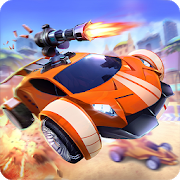
It's overly in overly you race to win against your opponent during the race, you're given different power-ups such as bombs balls rockets and shields which you have to use to win the race and defeat your opponent, the game has beautiful graphics but there is only one map however there's also a variety of racing cars available which promises to make this.
Sins Of Miami Gangster
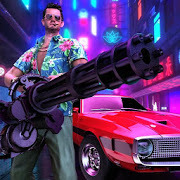
Its sins of Miami this is an open-world game where you're out for revenge against the Mafia dawn who killed your innocent family members, in this game you have to hit mafia gang members steal cars rob banks and many more similar types of missions the graphics and theme of this game are both on par with GTA vice city, the map of the city is large and there's plenty of stuff to do in the game.
War Tortoise 2
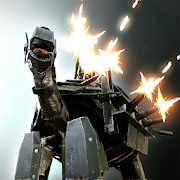
This is an offline idle game where you have to capture territory and shoot down the other mighty war tortoises and bugs, the graphics look pretty good and it looks even more impressive at night with the rain effect, you can also build your powerful army to fight against your enemy as well as defend your territory, overall the game is good and has a unique concept I really think you guys should try this game.
Gangs Town Story

This is an open-world game with a huge map where you can do anything, for example, you can steal a car or you can kill someone and the more crimes you, commit the more your wanted level will increase causing the police to come and arrest you there are a variety of vehicles weapons and skins making the game very impressive frankly.
Happy Wheels

Happy Wheels is a ragdoll physics web game created by fancy force happy wheels features, countless characters and vehicles to unlock in each level of happy wheels is a brand new experience survive deadly traps hazards and even your own bite turning against you as you battle to reach the finish line of each, stage though filled with blood and gore this dark and tricky physics-based puzzling arcade game can be funny for some yet horrifying for others happy wheels is an extremely popular game that.
Human Gang 2

This is a fighting and puzzle-solving game which is a little bit like human fall flat in the human game you solve logical and physical puzzles and have to fight against gangs using whatever means are at hand even transport you can pick up anything from your surroundings to hit your enemies with or to use to solve the puzzles the main character of this game is like a jelly man which is quite similar to the character from human fall flat.
Diggy dog 2
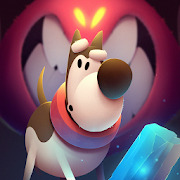
This is an offline puzzle-based game developed by Kingbird games, the game follows the story of a brave archaeologist dog named Marty, the gameplay combines the genres of digger and platformer during Christopher and Marty's adventure the player, explores dungeons full of challenging puzzles while finding a variety of items like equipment and countless artifacts and a larger space for making new discoveries.
wonder dragons

Wonder dragons is a casual match puzzle game where you complete levels by tapping on colored cubes to move them across a game board, in order to try to match two or more of the same color when a match is made those cubes are eliminated from the board and replaced with new one's matches of five or more cubes will create unique cubes like rockets bombs and disco balls these act as power-ups with larger board clearing the abilities there are various goals that must be completed with a fixed number of moves or in a limited amount of time during the game.
Star way

Star way is a fast-paced interstellar space puzzle game with unique arcade grappling movement in this game, you take on the role of a tiny astronaut a member of a great space team whose entire future depends on restoring all his potato chips which were accidentally scattered across space while carrying out his space puzzles, the player has to avoid a variety of obstacles in addition to collecting potato chips try to collect as many bonus stars. Read the full article
0 notes
Text
Ada’s Top 20 Films of the 2010′s

2010 seems long ago. It was the year when Netflix, previously a mail order DVD rental operation, launched its streaming service and changed our TV/movie consumption forever. Originally known for old favourites and terrible in-house productions, Netflix and its competitors such as Amazon Studios have gone on to become award season contenders in just a few short years. The functions of film festivals and movie theatres have shifted due to streaming services’ enormous effects. This decade also saw the warp up of some beloved sagas and series on the big screen - from Christopher Nolan’s Batman Trilogy to Harry Potter (more on those later!) Then there was an entire Star Wars Trilogy and end to a saga, which, love or hate it, was something many of us have been literally waiting our whole lives for. Throw in some Marvel at every turn, and an assuring expanse into the exploration of LGBTQ+ subjects, toss out Harvey Weinstein, and I think you have a reasonably accurate summation of film in the 2010′s. Something else close to my heart that unfortunately also fell to the wayside this past decade is Hong Kong cinema. Once famed for slick neo noir style action with an eye-popping blend of gun play and kung fu, the genre has died to a trickle as the Chinese film industry evolves. Without (much) further pre-amble, here is a list of my top 20 films of the 2010′s, chosen based on personal preference, and what I perceive to be cultural/technological/cinematic significance, presented in no definitive order...
The Social Network (2010) I talk about the things that were different at the start of the decade, and Facebook was certainly one of them. Although still a top contender in the social media minefield, at the beginning of the decade Facebook was king. From the cinema perspective, this was also a David Fincher directed, and Aaron Sorkin written film. These credentials aside, the film was additionally recognized for its editing, soundtrack, and transforming Jesse Eisenberg from the “poor man’s Michael Cera” (and what is Michael Cera doing these days again??) to a formidable dramatic talent. Altogether was a way to immortalize Mark Zuckerberg on screen eh? Inception (2010) Brace yourselves, I will tell you now that the 2010′s was the decade of Christopher Nolan for me. I didn’t realize until I compiled this list, that starting with this mind-bending thriller, every film he made this decade is right up there for me. Aside from its story, the stunning visuals, and pacing, Inception was cleverly tied together to give me one of the most unforgettable movie going experiences this decade. The Artist (2011) The best kind of homage here, and reminder that story and performance are what make up a good film. Is this an Art House film? Sure, but the story transcends even words, it’s a celebration, and a love story not just between two characters but to cinema itself.
Hugo (2011)
And speaking of celebration of cinema, does anyone really do it better than Martin Scorsese? In this case, an homage to a forefather of motion picture wrapped in the ultimate feel good family film. Seeing Melies’ films within a film, the automatons, and the blend of history and fantasy, make you believe. When asked to name a good family film, I often name this one. Harry Potter and The Deathly Hallows Part 2 (2011) The final film of the series and also my favourite chapter. Deathly Hallows is a good example where the 2-parter turns out to be a good idea rather than a mere cash grab (as in the case Twilight). It set a precedent showcasing the benefits of a longer story format that is enhancing for the story. Also, the Battle of Hogwarts, how do you get enough? Amiright? Super 8 (2011) 2011 was really the year of terrific family films. J.J. Abram’s Super 8 was no exception. It was through Super 8 that I was introduced to Abram’s sense of adventure and wonder through his characters. This was also Steven Spielberg produced adding to its positive attributes. When Abrams made Star Wars: The Force Awakens later in the decade, I was thrilled he was at the helm based on my love for Super 8. Moonrise Kingdom (2012) A different family film by Wes Anderson, and also one of the most endearing love stories told on the big screen this year. His follow up The Grand Budapest Hotel was also a contender for my best of the decade list but ultimately the unconventional young couple in Moonrise Kingdom versus the flagrantly over the top romantic gestures in Grand Budapest helped me make my choice. Still, both are visually spectacular. The Dark Knight Rises (2012) Christopher Nolan film #2 and the close out to the best Batman trilogy. While a certain level of campiness has come to be associated with preceding Batman offerings, Nolan and Christian Bale did something different and in turn won over a lot of new audiences for the superhero genre. While you can’t turn these days without bumping into a Marvel, etc. production, I think the quality of superhero films was raised leaps and bounds this decade and much of it in thanks to Nolan’s Dark Knight trilogy which began in the decade before. Dallas Buyers Club (2013) Oscar accolades (and Jennifer Garner) aside, Dallas Buyers Club by Canadian filmmaker Jean-Marc Vallee told a important story and told it well. It also brought Vallee’s work to a larger scale audience than any of his previous projects, giving him the attention he so very much deserves. From set design to story to acting, I truly believe this was one of the best films of the decade.
The Theory of Everything (2014) I may be partial to biopics but there’s no denying the venerability of Stephen Hawking, and Stephen Hawking as portrayed by Eddie Redmayne... well, there are no words! Boyhood (2014) When I first began compiling this list, Boyhood was one of the first few films to come to mind. Aside from being directed by one of my favourite filmmakers Richard Linklater (who was also featured in my 2000′s list with Before Sunset - which I argue is still the best of the trilogy) it was also a very ambitious undertaking as a filmmaker. It’s my hope that the significance of Boyhood isn’t diminished in the age of digital aging/de-aging technologies, to do something like this organically is a labour of love. To commit to a project that spends 12 years in production is firstly insanity, but then to have a finished product that ties so seamlessly together in a tale of family, life, and love. Who knows if this will ever be done again? Interstellar (2014) Christopher Nolan film #3. I’m not as into movies about space and time travel as I was as a teenager/young adult, so I’m of the belief that while I still watch a fair amount of them, fewer and fewer truly stand out. When it came to explore this decade’s offerings, Interstellar and First Man were the only two even worth mentioning to me. The latter was more traditionally biopic-ish, though well told, and I maintain has the best soundtrack of 2018. Interstellar on the other hand had other thought-provoking layers (as I have come to expect from Nolan). What We Do in the Shadows (2014) And now for something completely different! What would life be like if Taika Waititi didn't make films? Mankind has been telling stories since the beginning of time so it’s understandingly hard to come up with truly original stories after thousands of years, and yet... Taika Waititi does it! Seriously though , What We Do In the Shadows was the single funniest film I’ve watched this decade. Mad Max: Fury Road (2015) If What We Do in the Shadows was the funniest movie of the decade, then Mad Max: Fury Road had to be hands down the most intense, non-stop, adrenaline rush thriller. Again, I watch a lot of this stuff and find myself largely disillusioned or unimpressed with most of what’s out there. Sure, I love the Avengers movies, and I’m always up for gratuitous violence but so few of these films will make me stop everything that I’m doing and stay rooted on the spot for the entire film - which I can recall distinctly is what happened when I put on this film on in early 2016. The Hateful Eight (2015) Westerns aren’t my cup of tea, but it’s common knowledge that Quentin Tarantino certainly is. When it came time to choose a QT film for my list, and we all know that’s exactly how I went about it. Once Upon A Time... In Hollywood was never even a contender, it was between Django Unchained and The Hateful Eight, overall I appreciated the simple (but elaborate!) set up of a cast of questionable characters in a cabin that kept me entranced for near 3 hours just listening to them talk. Straight Outta Compton (2015) Ok, there’s a clear nostalgia factor in play here, but Straight Outta Compton was also straight up good storytelling, coupled with a badass soundtrack. I didn’t give it much thought until later, but there’s also a certain level of accessibility in the storytelling, it was a film that was made for a wide audience without sparking disdain from dedicated members of the rap/hip hop community (not much significant backlash that I'm aware anyway... As someone who’s been devoted to certain subcultures, I can vouch this is entirely a possibility.)
Blue Jay (2016) Who has no idea what film this is? Hint: go watch it on Netflix. In the 2000′s I included Conversations with Other Women in my top 20 list, I feel like Blue Jay is my 2010′s equivalent. Not that I was looking for an equivalent but I have an appreciation for unforgettable stories about the undeniable attraction between two people who have previously had a failed relationship with each other. It's Sarah Paulson and Mark Duplass on screen the entire time, and it's completely engrossing. Not an easy feat, not appreciated by many, but glorious to me. Call Me By Your Name (2017) This is my Ghost World of the 2010′s, not because the content is at all alike, but because it’s the only movie I watched repeatedly, and the only book in history that I’ve read twice in a single month. Some stories just touch you, this one did. Factor in the brilliant performances, the exquisite writing, beautiful settings, music, and every intricacy that together made up the whole film. I only wish I had more pretty words to give it a proper description but I will never come close to what Andre Aciman and James Ivory and Luca Guadagnino put on screen. Dunkirk (2017) Christopher Nolan film #4. Dunkirk was the first film I thought of when I started to make this list. It seemed so obvious. While I said I wasn’t ranking these Top 20 films of the decade, if hard pressed, I would put Dunkirk at the top. Not merely a good historical drama, this was a technical achievement. There’s a lot of articles out there about how a special plane was refitted to house the camera, you can read those online. What I think needs to be mentioned more often is astounding sound mixing and design in Dunkirk. It’s so good, and I’ve been privileged to see it in 70MM and in Imax that I’m hesitant to watch it in my home with my dinky home theatre now. When they update the history of film textbooks, they’d better be adding Dunkirk. The Irishman (2019) Ok, so maybe this isn’t Marty’s best. Maybe it’s a slight rehashing of his best work. (But his best is so good, the rehashing is still miles beyond the rest!) But to me, it’s Martin Scorsese embracing the evolution of storytelling in film, the formats in which it's presented, and how he’s going to adapt it in his favour. What you have here is an excessive piece of work that would likely not ever have been made in the last 50 years due to cost, impracticality, audience appreciation, what have you. However, in an unexpected turn, longer formats have come back into favour, and found a new platform in which to present themselves (ie. streaming servies like Netflix) So here he is, and here is The Irishman. There you have it movie lovers, more or less my top 20 films for the 2010's. Here is an abbreviated recap:
The Social Network - dir. David Fincher (2010)
Inception - dir. Christopher Nolan (2010)
The Artist - dir. Michel Hazanavicius (2011)
Hugo - dir. Martin Scorsese (2011)
Harry Potter and the Deathly Hallows Part 2 - dir. David Yates (2011)
Super 8 - dir. J.J. Abrams (2011)
Moonrise Kingdom - dir. Wes Anderson (2012)
The Dark Knight Rises - dir. Christopher Nolan (2012)
Dallas Buyers Club - dir. Jean-Marc Vallee (2013)
The Theory of Everything - dir. James Marsh (2014)
Boyhood - dir. Richard Linklater (2014)
Interstellar - dir. Christopher Nolan (2014)
What We Do in the Shadows - dir. Taika Waititi (2014)
Mad Max: Fury Road - dir. George Miller (2015)
The Hateful Eight - dir. Quentin Tarantino (2015)
Straight Outta Compton - dir. F. Gary Gray (2015)
Blue Jay - dir. Alex Lehmann (2016)
Call Me By Your Name - dir. Luca Guadagnino (2017)
Dunkirk - dir. Christopher Nolan (2017)
The Irishman - dir. Martin Scorsese (2019)
Just missing the list was The Favourite - dir. Yorgos Lanthimos (2018). I actually miscounted my movies during the first draft of this list and originally had this to say about The Favourite when I'd mistakenly thought it'd made the list:
The Favourite (2018) This is the only film on the list that's not here because of its story. It’s not a bad story, but plot alone wouldn’t put The Favourite amongst my favourites. (Also a part of me has yet to forgive Yorgos Lanthimos for making me endure Dogtooth) What makes The Favourite stand out is that it’s genre-bending, it’s like an absurd period piece for lack of a better description, and it’s awesome. Also the camera work including those panning shots with an extreme wide angle lens combined with the elaborate costume design really makes the film pop visually in a most wonderfully unconventional way.
Other films that didn't wind up making the cut:
The Town (2010)
Last Night (2010)
Rare Exports (Finland 2010)
Django Unchained (2012)
Cloud Atlas (2012)
Inside Llewyn Davis (2013)
Captain Phillips (2013)
Star Wars Episode VII: The Force Awakens (2015)
The Danish Girl (2015)
Get Out (2017)
The Shape of Water (2017)
The Hate U Give (2018)
And two others I'd like to mention are:
1. Beasts of the Southern Wild (2012), which is an affecting film but admittedly will never be my cup of tea. Doesn't mean it's not great. And,
2. Eden (France 2014) a personal favourite that I had not even considered for one of the 20 best films of the decade, but delightfully it showed up on a Vulture article about the best films of the decade in 47th place (coincidentally the writer's initials are also A.W. and this is what they had to say...)

There you have it, my decade in film summed up. I look forward to sharing many more film experiences and thoughts with you in the years to come. Our annual January challenge "30 Films in 31 Days" commences for another year starting tomorrow, and I hope to be able to follow shortly after with my top films of 2019. Happy movie-going and happy new year!
0 notes
Text
THIS IS WHY YOU DO BETAS

We try to make the best possible product within the constraints placed on us (far and away the biggest one being time). At the same time, you just have to resign yourself to the fact that you’ll never catch every last problem. No matter how many times you read the text, it can’t compare with hundreds or thousands of fresh eyes going over it.
This is where the internet comes in. In ye olde days, you took in the feedback from your few playtest groups, put out your final release, and hoped for the best. After that point you could only wait to see who would write you letters or speak to you at cons and point out the things you’d goofed on. Now we can reach so many more people, so that the final product is better and any eventual errata file is shorter (you’re still not going to get everything, though). Everyone wins. Along those lines, the beta period for the upcoming BattleMech Manual was very fruitful. We have nearly 200 changes, ranging from “replace this capital W with a lower-case w” to “replace this entire page with the following new text” (I’m particularly happy with how the thorny issue of displacement was dealt with). Overall, the book will be better than ever due to your feedback, and we thank you for that.
One particular bit of feedback noted something we hadn’t considered much at all, however. The original idea for the book was a strictly Tournament Legal volume (using the formal definition in BT). As time went by, the scope of the book changed and we abandoned the idea of worrying about rules levels in the Manual. However, the list of what equipment was to be in the book still reflected that Tournament Legal mindset: only TL-rated items made the cut.
The most recent Technical Readouts – Prototypes, 3145, and 3150 – wholeheartedly embraced the host of new weapons and equipment in use in BattleTech since Tactical Operations appeared. The ’Mechs in those volumes really push the envelope in terms of equipment options. However, a lot of that gear isn’t rated as Tournament Legal. The result was that many of the machines in those Technical Readouts weren’t 100% supported by the BattleMech Manual.
Now, as we’ve said from the beginning, the Manual was never intended to cover everything (“90% of stuff used by 90% of players”, was the mantra). A lot of the equipment on the machines in those three Readouts pretty much only appears there; it’s niche. But as time goes by and the BattleTech timeline marches ever onwards, it becomes an ever-larger niche, and by lacking a lot of that equipment, we were letting our post-Jihad playerbase down. So, even though these items aren’t in use by a large number of ’Mechs to date, we realized we need to add some of them to the Manual.
But what to add? Of the 122 ’Mechs in the three Technical Readouts under discussion, 73 aren't 100% usable by the Manual beta (sometimes this is just one item, sometimes not). The problem is that those 73 ’Mechs are that way because of 38 different pieces of technology. A lot of those 38 pieces might only show up on two or three ’Mechs, or even just one (Blue Shield PFD only on the Quasimodo, mining drill only on the Violator: I’m looking at you guys). Some of those pieces require a lot of rules text to describe how they function (handheld weapons and remote sensors each require an entire page). Adding all that would bloat the Manual–the exact thing we designed it to avoid.
So, we compromised. Thirteen more items are being stuffed into the Weapons and Equipment chapter: the most common post-Jihad weapons, equipment, and construction options with gameplay rules. They are:
AES
Armoured components
Ballistic-reinforced armour
Boosted C3
Ferro-lamellor armour
Hardened armour
Lance
Partial wing
Re-engineered lasers
Reflective armour
Talons
Vibroblade
XXL engine
Their entries are trimmed down from their original appearances in Tactical and Interstellar Operations, as befitting the scope of the Manual (for example, there’s no table telling you how to use Partial Wings in non-standard atmospheres or with ProtoMechs, because the Manual doesn’t deal with those things). But they’re fully detailed for gameplay using the Manual and, overall, their addition greatly expands the list of 100% usable post-Jihad BattleMechs. (As an aside, because the room was there, we’re also adding one more new quirk, one that should make Succession Wars-era players happy.)
Thanks again everyone for your feedback!
--Keith Hann
#Battletech#MechWarrior#BattleMech Manual#tabletop#tabletop gaming#tabletop miniatures#games#gaming#Catalyst Game Labs
26 notes
·
View notes